
Ancient
History
& Archaeology
Welcome to Gobekli Tepe - 12,000
years old
Built by hunter-gatherers before
metal tools and farming!
This page is one small part of Good Sites for Kids!
(click below for other Social Studies sites)
|
|
|
Look
for ![]() to
see what's been added lately!
to
see what's been added lately!
Bell (Lai Zhong) - The Cleveland Museum of Art
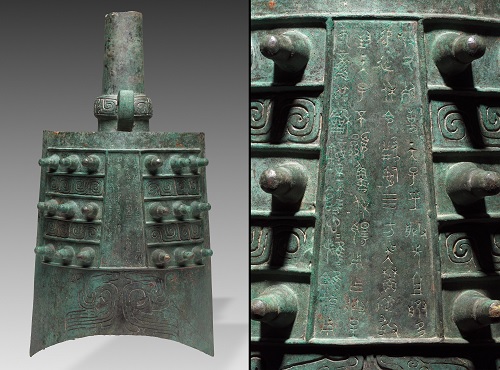
One of Lai's Bells, with inscriptions about why
it
was made. From a set of eight.
China, Western Zhou dynasty, 800–700 BC
"This bell bears an inscription of 118 characters
about its owner, Lai, and why it was cast.
Lai's ancestors dutifully served the Western Zhou
royal court, and he was granted a hereditary
position by the Son of Heaven. To express
filial piety, Lai commissioned a set of bells
as an offering to his father, Gongshu, in the
hope that they would be forever treasured
by future generations."
The Islamic Emirate of Sicily
ruled Sicily from the 800s, after
chasing the Roman Byzantines out.
In 1071, Norman adventurers conquered
southern Italy, Sicily, and Malta. They liked
the Muslim artists who carved ivory horns
like the one above
and patronized the arts.
Count Roger I of Sicily
owned this horn.
Happy New Year 4,000 BC!
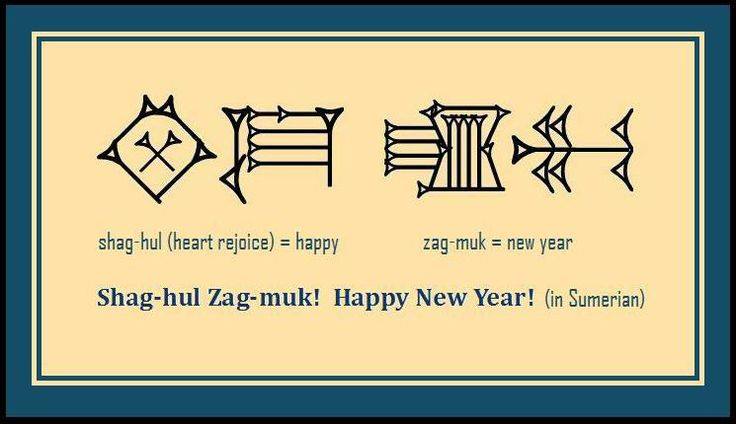
Brief
History of the Assyrians These ancient people of
the Bible
are still around today. Read all about them at this site!
Ruins of an Assyrian outpost
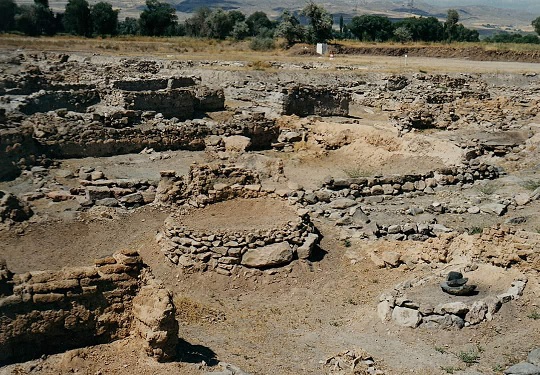
Cast reconstruction of Babylonian Flood Tablet
(Emma Elias: We Love Mesopotamia)

19th century, after 7th century BC original
This object is a modern version of the Flood Tablet,
a cuneiform-inscribed clay tablet which is an account of
the deluge featured in the Epic
of Gilgamesh. It was not
cast from an ancient tablet but rather from a 19th
century interpretation based on multiple ancient
fragments.
Assyriologist Paul Haupt made the modern tablet in clay,
basing its size and shape on an example held in the
British Museum and reconstructed from several fragments.
The original was part of the Library of Ashurbanipal
(r. ca. 669-631 B.C.) at his palace in the Assyrian capital,
Nineveh, in northern Iraq.
The World's Oldest Complaint Letter
Dating to approximately 1750 BCE and recovered from the
ruins of the city of Ur, the tablet is a customer complaint
from merchant named Nanni to a supplier known as Ea-nasir.
In fact, there are multiple complaints in the letter. Ea-nasir
apparently delivered the wrong grade of copper after his
Persian Gulf voyage to Dilmun
to collect the metal. He’s also
responsible for the misdirection and delays in another delivery.
And to top it all off, he was rude to the servants Nanni sent to
collect the delivery.
(Note: Dilmun was also called Telmun,
it's the same place.)
Ea-nasir bought copper ingots at Dilmun.
Ancient Dilmun was located on the island of Bahrain.
It spread along the coast but the trading hub was around
Saar and
the harbors
at the north end of Bahrain island.
It was the great trading center for the area.
Merchants and traders from Meluhha
(the Indus
Valley Civilization) had a colony in Dilmun.
The merchants of Dilmun had a monopoly on the copper trade.
Copper was brought from the nearby mines of Oman and shipped to
Mesopotamian cities, Egypt, the Indus Valley, and places in between.
The actual letter:
“Tell Ea-nasir: Nanni sends the following message: When you came,
you said to me as follows : “I will give Gimil-Sin (when he comes)
fine quality copper ingots.” You left then but you did not do what
you promised me. You put ingots which were not good before my
messenger (Sit-Sin) and said: “If you want to take them, take them;
if you do not want to take them, go away!” What
do you take me for,
that you treat somebody like me with such contempt? I have
sent
as messengers gentlemen like ourselves
to collect the bag with my
money (deposited with you) but you have treated me with contempt
by sending them back to me empty-handed several times, and that
through a war zone!
Is there anyone else among the merchants who trade with Telmun
who
has treated me in this way? You alone treat my messenger with
contempt! On account of that one (trifling) mina of silver which I
owe you, you feel free to speak in such a way, while I have given to
the palace on your behalf 1,080 pounds of copper, and Umi-abum* has
likewise given 1,080 pounds of copper, apart from what we both have
had written on a sealed tablet to be kept in the temple
of Samas.**
------------------------------------------------------------------------------------
(*Umi-Abum was another merchant, a business partner, a family member,
who knows?)
**(In ancient times, from Ur to Rome, money and other valuables
were
kept under guard in temples along with government funds and temple
money. There were no banks in those days.)
-------------------------------------------------------------------------------------
How have you treated me for that copper? You have withheld my
money
bag from me in a war zone; it is now up to you to restore my money to
me in full. From now on I will not accept any copper from you that is not
of fine quality. (Implied: I am not sending any more employees to pick
it up from you. From now on, you will bring it to
me!)
I shall from now on select and take the ingots individually in my own
yard, and I shall exercise against you my right of rejection because
you have treated me with contempt.”
The “Complaint Tablet To Ea-Nasir” was found in the ruins of
Ur inside an
old Babylonian-style house, which may have been the residence of Ea-Nasir.
Notice the letter is still set inside the original clay cover that was
supposed to protect legal bdocuments.
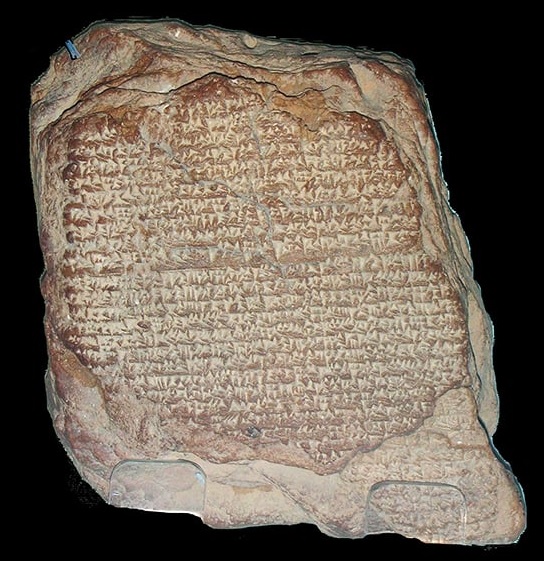
23,000-year-old
foootprints in New Mexico
People were in North America thousands of years
before we thought. Before the end of the Ice Age.

More links:
White
Sands National Park Footprints Offer Glimpse
into Life of a Prehistoric Mom and Child
Ancient
Footprints Push Back Date of Human Arrival in the Americas
NYT article
High
Country News article: "White Sands discovery only confirms what
Indigenous people have said all along. We have been here since time immemorial.”
Bronze Age Bodies Found Under Primary School in Edinburgh
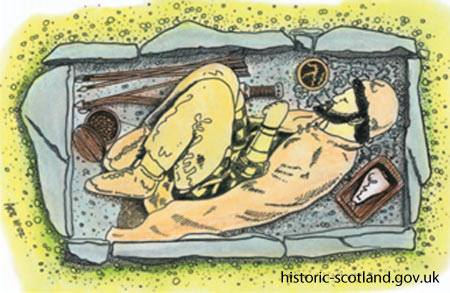
Robert McAngus The McAngus Clan
Bronze Age Bodies Found Under Primary School in Edinburgh
Archaeologists have found two Bronze Age bodies beneath a
primary school in Newhaven, Edinburgh, and they believe
there may be many more.
The ancient remains were found during a routine survey ahead
of a carrying out a building extension to the school.
Archaeologists were stunned when they came across the burial
plots, which have been dated to approximately 2,000 BC.
The skeletons were found lying on their sides in a crouching position,
an ancient tradition relating to the belief that the deceased were
merely resting before waking in the afterlife. They were often
buried with pots containing food and drink to sustain them for the
journey to the next world.
“It’s a definite style which is very indicative of a prehistoric burial,”
said John Lawson, archaeology officer at Edinburgh City Council.
Crouched burials were often oriented north-south, and there were
typically strict rules determining the position and grave goods of
the deceased, depending on their gender and social status.
Females were placed as a rule on their right side with their head
towards the south; males were on their left side with their head
towards the north, thus both would face east, towards the rising sun.
News reports of the Newhaven discovery have not announced the
positions of the two individuals that were found.
Dr Alison Sheridan, principal curator of early prehistory at the
National Museums of Scotland, believes the two graves may be
part of a nationally significant network of burial plots and that a
Bronze Age settlement probably existed near to where Edinburgh
is now. She hopes that, if the skeletons are well preserved enough,
they will provide a treasure trove of information, such as age, gender,
diet, where they came from, and possibly how they died. “What’s
interesting is that, although Edinburgh is quite built up, you
occasionally get these magic moments which provide a window
to the past,” she said.
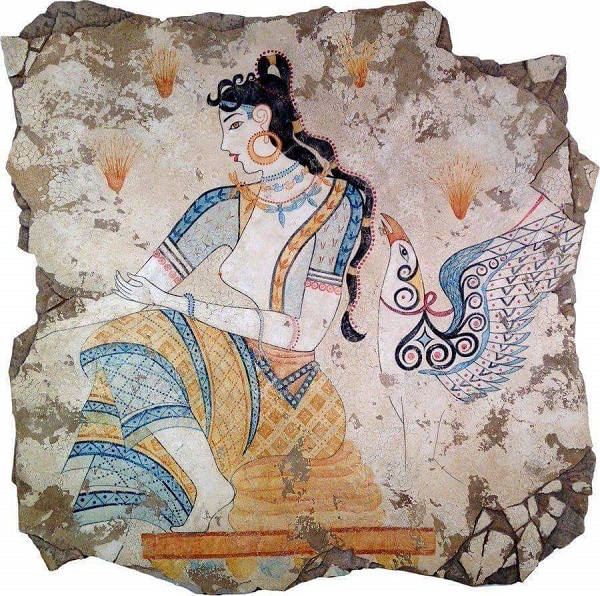
A vividly restored Minoan fresco of the "Saffron Goddess"
Approximately 3,600 years old, it was discovered in the
prehistoric city of Akrotiri on Santorini (ancient Thera)
Greece.
source = Ancient Civilizations
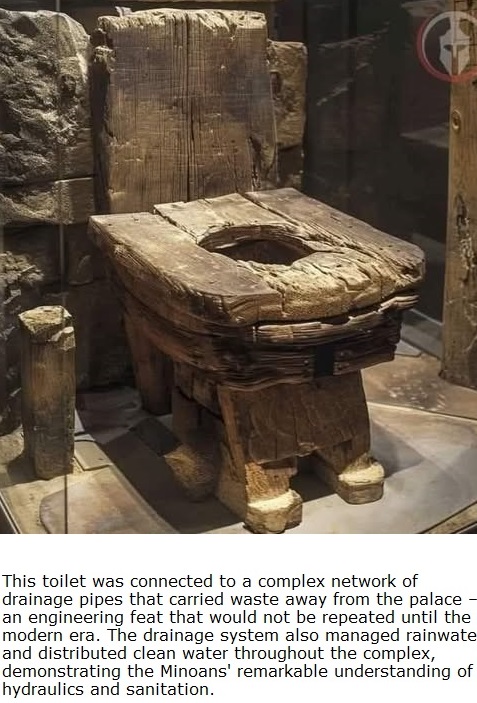
The 'Nebra
Sky Disk' with two bronze swords and axe heads
uncovered from Saxon-Anhalt, Germany and dated to 1600 BC.
This incredible discovery of the oldest depiction of the universe
was almost lost to the black market.
Dated to 1600 BCE, this bronze disk has a diameter of 32cm
(about the size of a vinyl LP) and weighs around 2 kg.
It is patinated blue-green and embossed with gold leaf symbols
which appear to represent a crescent moon, the sun (or perhaps
a full moon), stars, a curved gold band interpreted as a sun boat,
and a further gold band on the edge of the disk which probably
represents one of the horizons. - source = Museum
of Artifacts
40
maps that explain the Roman Empire from Vox
"Two thousand years ago,
on August 19, 14 AD, Caesar Augustus died. He was Rome's first emperor,
having won a civil war more than 40 years earlier that transformed the
dysfunctional Roman Republic into an empire. Under Augustus and his
successors, the empire experienced 200 years of relative peace and
prosperity.
Here are 40 maps that explain the Roman Empire — its rise and fall,
its culture and economy, and how it laid the foundations of the
modern world." Vox's excellent choice of maps and trivia graphics
explain everything about the Empire. CAUTION
- Item # 19 is
inappropriate for under 18. R-rated ancient painting
(one of the
milder ones from Pompeii). Commentary R-rated also. If you're
a parent or a teacher, you will probably want to leave # 19 out.
Romans saw these as harmless fertility symbols.
We see them as not worth unemployment.
Shield Wall! Bordweal! Skjaldborg!
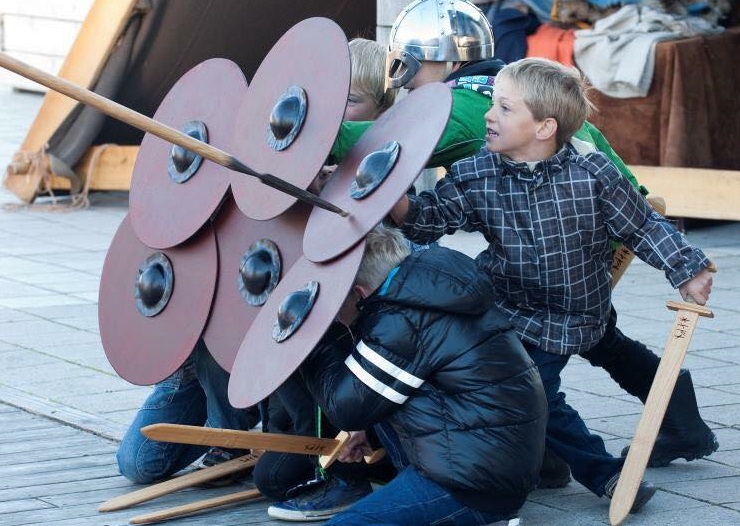
139
Old Norse Words That Invaded The English Language "Without the Vikings,
English would be missing some awesome words like berserk, ugly, muck, skull,
knife, die, and cake!" "Traust me, þó (though)
it may seem oddi at first, we er still very líkligr
to use the same words as the Vikings did in our everyday speech. Þeirra
(their) language evolved into the modern-day Scandinavian languages, but þeir
(they) also gave English the gift of hundreds of words." For more advanced
learners, here is an article about the Yorkshire
dialect*, spoken in northeast England (where the old Danelaw was).
* It's chock-full-o'-Norse!
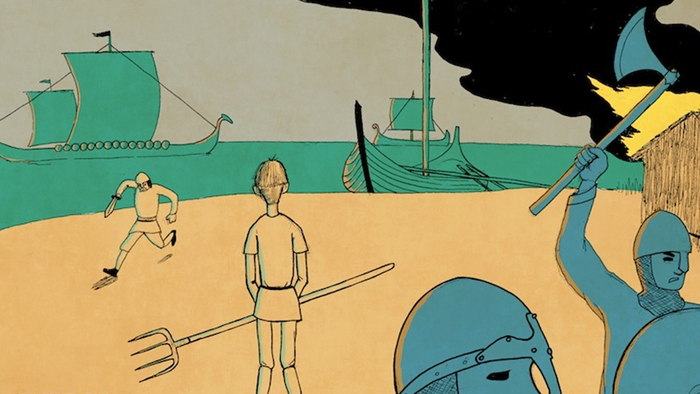
Snakker du Norsk?
1812History.com
"From 1812 to 1815, the inhabitants of what was to become Canada fought
side by side with the British forces and their First Nation allies to defend
their lands against the Americans. The battles were waged on land and sea
on both sides of the border. The impact of the War was felt by all. This website
is dedicated to make the surviving records and artefacts from this time period
available to everyone. There is much to discover about the War of 1812 era."
This Canadian Heritage site has over 1,000 archaeological artifacts (buttons,
musket balls, knives, pieces of uniforms, etc - real
battlefield archaeology), original letters and other documents, period
battle art, much more. Talk about Primary Sources!
2,000 year old sock from Egypt
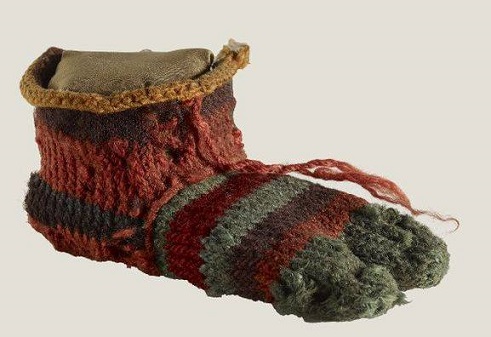
Nålebinding
("single needle knitting") is an ancestor of knitting. Viking crafters
were very big on this style.
This child's sock is from ancient Egypt, in Coptic style; wonderful how it
has kept its colors!
Coptic Christians of Roman Egypt liked to make a separate pouch for the big
toe. Japanese work boots still have them today.
Ancient
Silk Road – First Global Supply Chain
This is a commercial site that specializes in teaching
principles of business and logistics through case studies.
Accurate and wonderful descriptions and maps explain
the distances, trade goods, and the cities along the way.
Students do NOT have to subscribe and do the case study
(unless they want to and have the funds and the knowledge).
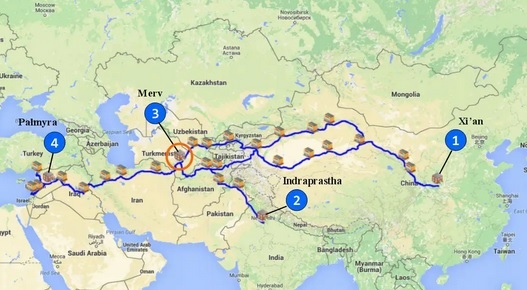
"The Ancient Silk Road was approximately 4,000 miles (6,440
km)
from its start in China to its end on the shore of the eastern
Mediterranean. This compares with 2,440 miles ( 3930 km) between
New York and Los Angeles, and 1,760 miles (2,830 km) between Paris
and Moscow."
Covers the oasis cities, the camels that carried the goods, the
various merchandise they transported:

"You are head of the largest merchant trading house on the Silk Road.
It is
the year 210 AD, and the long prosperity of the Pax Romana has created
strong demand in the Roman Empire for the luxury products you import from
China and India. Chief among those products is silk. Everybody who is
anybody wants their clothes made of silk.
Along the length of the Silk Road stretching from the borders
of the
Roman Empire in the west to the Middle Kingdom (China) in the east,
there are many cities and many merchants, yet all know your company and
your name : you are the Trading House of Barmakid, in the city of Merv."
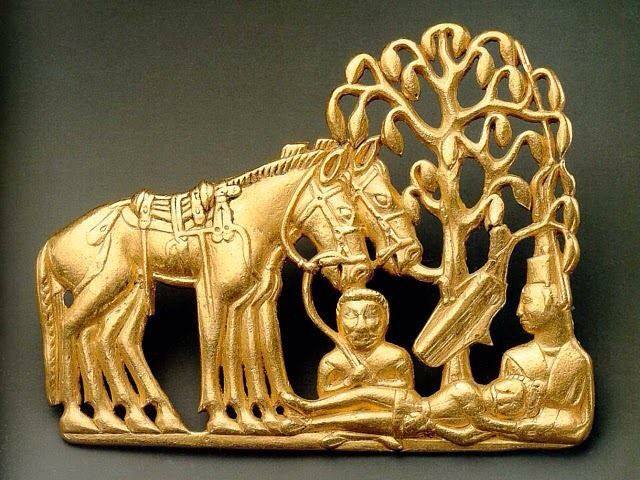
Sumeria
Mesopotamia:
Scythian tree of life. Golden plaques representing the resurrection of a dead
hero
(Saka - Scythian culture, 5th century BC, Hermitage Museum).Scythian art is
art,
primarily decorative objects, such as jewellery, produced by the nomadic tribes
in the area known to the ancient Greeks as Scythia, which was centered on
the
Pontic-Caspian steppe and ranged from modern Kazakhstan to the Baltic coast
of modern Poland and to Georgia.
Archaeologists
Unearth Buddha Statue in
Ancient Egyptian Port City

Roman Egypt had Buddhist missions and trading posts.
There was a thriving trade across the Indian Ocean.
Archaeology
for Kids and Teachers - Lesson Plans, Activities, Games, ...
from archaeology.mrdonn.org
(a great source in its own right)
This is a Pinterest page so it has oodles of other activities listed!
Skeletons, architecture, Egyptian clothing, making rafts, making stone axes,
food preparation, lots of timelines, how to excavate, cave cultures, American
mound builders, make a Great Wall with Rice Krispies, Lewis & Clark,
building ancient cities with legos..

Once upon a time, you could walk from France
to the British Isles;
from the Netherlands to Norfolk and on to the Orkneys and Eire!
During the last Ice Age, people lived and hunted on the floor of the
North Sea. This happened all over the world during this Ice Age.
Beringia and Sundaland
are two other flooded lands that used
to be land bridges.
.
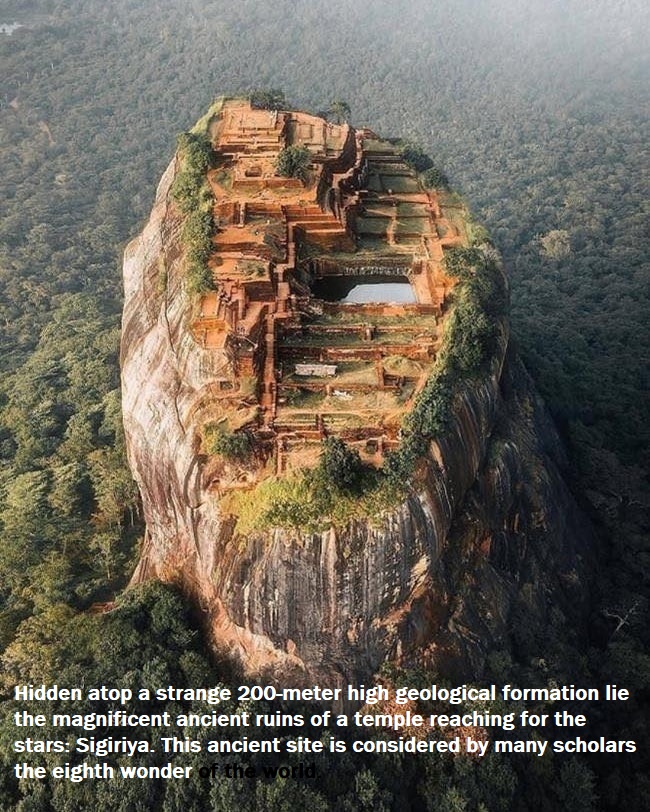
The
Roman Empire from Quora
"The History of the Roman Empire from Rise to Fall"
This is a long list of curated, good questions sent
in by curious people. These are answered by
experts in the topics. The same format that Quora
uses for all their subjects. A good place to get
(sometimes obscure) questions answered.
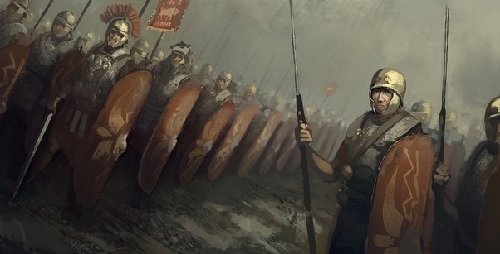

Golden bust of the Roman
Emperor Marcus Aurelius
Last of the Five Good
Emperors, Stoic
philosopher, author
![]()

Did
Lead Poisoning End the Roman Empire?
Romans used enormous amounts of lead. Lead can
poison you. Did lead poisoning help destroy Rome?
Six minute video from the American Chemical Society
examines the facts and findings.
The
Siege of Jerusalem (70 AD) - The Great Jewish Revolt
This video is 44 minutes long and covers everything.
Click the picture to see a shorter but still good video.
A Day in Pompeii 9:39 Youtube short about the eruption of August 24-25, 79. This has sound, special effects; you are there, looking out an upper story window. It's scary and eerily fascinating. Sometimes watching is more effective than reading.
" A Day in Pompeii, a Melbourne Winter Masterpieces exhibition, was held at Melbourne Museum from 26 June to 25 October 2009. Over 330,000 people visited the exhibition -- an average of more than 2,700 per day -- making it the most popular traveling exhibition ever staged by an Australian museum.
Zero One created the animation for an immersive 3D theatre installation which gave visitors a chance to feel the same drama and terror of the town's citizens long ago, and witness how a series of eruptions wiped out Pompeii over 48 hours."
A World of Myths - Mythology from Around the World "Welcome to aworldofmyths.com - a collection of articles devoted to the Gods of the ancient world and the adventures of its greatest heroes." Bios of Greek, Roman, and Norse gods and myths associated with these cultures. Includes quite a bit of art and some videos. Interesting fonts, too. A good resource. From Viktor Andonov, who also gave us World of Tales, which is in our Literacy > Children's Literature section.
Four Videos of Roman Houses
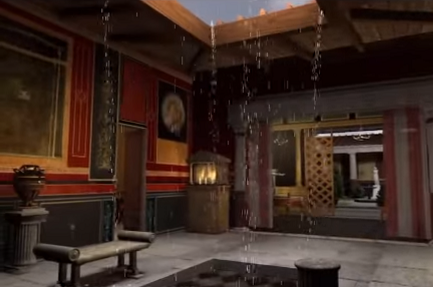
Stunning 3D Animations Showcase The Internal Layout Of The Roman Domus (House) "... a typical Roman domus served as a dwelling for the Roman familia, while being (sometimes) used as a ‘personalized’ center for business and religious worship." A domus was designed for "higher middle class Roman citizens", when those people were not living in a villa at their country estate. This animation takes you through the house and grounds, and the article shows blueprints and explanations, too. "The resourceful folks over at Ancient Vine and Museum Victoria have given a go at virtually reconstructing the typical Roman domus of a ‘well-to-do family."
The second video "showcases the Roman domus of Domitia Longina, wife to the Roman Emperor Domitian, who lived from 55-126 AD. Suffice it to say, the house was bigger than the typical Roman domus, and as such also consisted of a thermae – a bathing facility specifically constructed within the compound of the residence." Superb animation and music.
The third video, Ancient Roman Homes of the Rich, is narrated. Everything important is labelled, in Latin. This video covers things not often discussed in these short videos; such as water, plumbing, radiant heating, baths, the various entrances, dining, and bedrooms. ©2014 David Egan Productions.

The 4th video is titled: 3D Animation Reconstructs An Upper-Class House Of Pompeii Before The Vesuvius Disaster "The domus we see here belonged to Caecilius Iucundus, a wealthy banker from Pompeii who lived almost 2,000 years ago. The house was located in the city block termed as Insula V1, which was thoroughly analysed by 3D scanning and drones (conducted during fieldwork expeditions between 2011 and 2012). The site itself was chosen because of its ‘prime’ location at the crossing of two of Pompeii’s main thoroughfares. Suffice it to say, the neighborhood with its easy access to the city’s commercial facilities translates to the affluence of Iucundus and the opulence of his house." Remember, dear students, if you see a fancy word you do not understand, look it up!
History of the Roman Colosseum 10 minute video quickly covers the history, starting with the new Emperor Vespasian's desire to replace Emperor Nero's vast "Golden House" complex with something for the people. Construction, layout, the retractable top, stairs, elevators, and restaurants! The early Coliseum was regularly flooded so that sea battles could take place. Nero's "plumbing" - tunnels for filling and draining - are explored. The Hypogeum was built later. All its fascinating parts are examined, even the elevators.
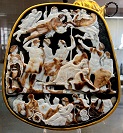 Ancient
Roman Cameos from Ancient
Links. "So, what on Earth is a cameo anyway? It's an engraved gem,
or a piece of jewelry that contains a relief image on a negative background,
called intaglio... Ancient Roman cameos were made mostly of semi-precious
stones, such as agate, onyx and sardonyx, and are known today as 'hardstone
cameos'. The Romans also created glass cameos..." This is very beautiful
art. Here are eight of the very best surviving Roman cameos, including the
largest - Great Cameo of France. The best, most famous glass cameo, the Portland
Vase, is also shown. Many cameos made political statements, and this is discussed.
There are more cameos on Pinterest. "...the Kunsthistoriches Museum in
Vienna has the best collection of ancient Roman cameos in the world. Go check
it out." If you can't go in person, you can see them online.
Ancient
Roman Cameos from Ancient
Links. "So, what on Earth is a cameo anyway? It's an engraved gem,
or a piece of jewelry that contains a relief image on a negative background,
called intaglio... Ancient Roman cameos were made mostly of semi-precious
stones, such as agate, onyx and sardonyx, and are known today as 'hardstone
cameos'. The Romans also created glass cameos..." This is very beautiful
art. Here are eight of the very best surviving Roman cameos, including the
largest - Great Cameo of France. The best, most famous glass cameo, the Portland
Vase, is also shown. Many cameos made political statements, and this is discussed.
There are more cameos on Pinterest. "...the Kunsthistoriches Museum in
Vienna has the best collection of ancient Roman cameos in the world. Go check
it out." If you can't go in person, you can see them online.
Ancient Colosseum: A Virtual reality experience with Oculus Rift This 5 minute video concentrates on the atmosphere of structure and the place. The Colosseum was designed to impress the audience with its incredible awesomeness. The sound of the audience adds to the ambience.
The world's largest ancient mosaic was uncovered in Antakya,
Turkey. It covers 9,000 square feet (836 m2) and was made
in the late Roman period, 4th century AD
Five sites about aqueducts:
How a Roman Aqueduct Works This site is a one page overview of aqueducts. People had to find ways to bring water to where they lived. Romans, with their engineering genius, overcame their water problems with aqueducts. Tunnels, bridges for the water, inverted siphons to pull water uphill, dams, distribution tanks and conduits to carry water all over the city, all these things took skill to design and build.
Roman Aqueducts "This website on Roman aqueducts aims to show what marvelous work has been done by engineers and architects of the Roman empire." This is a multipage, graphic-intensive site with all the data you could ever want. Drawings, photos, facts, even slideshows.
Qanats The aqueducts of the Middle East. Underground tunnels carried water for many miles. Romans used them as part of their aqueduct systems. They are still in use in Iran and some other places in the Middle East, and in western China. "There are significant advantages to a qanat water delivery system including: (1) putting the majority of the channel underground reduces water loss from seepage and evaporation; (2) since the system is fed entirely by gravity, the need for pumps is eliminated; and (3) it exploits groundwater as a renewable resource."

No mystery here! It's a puquio, the New World version of a
quanat. Similar to the ones in the Middle East and Asia because
there's only one way to move large amounts of water underground.
Today we use big underground pipes. In ancient times they had
to dig tunnels using hand tools. The holes are to oxygenate the
water and give access to the quanat. The New World versions,
(puquios) have exotic spiraled access holes, the better to channel
winds into the canals.
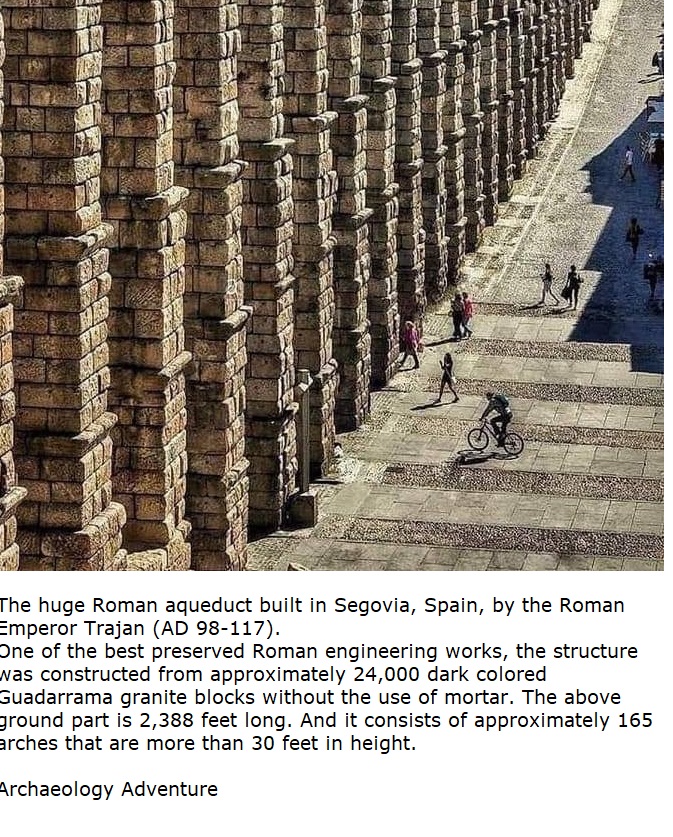
Barbegal aqueduct and mill This complex, built by Roman engineers.
near Arles along the Rhone River a few miles north of the Mediterranean
Sea. It was powered by water, tapped off a nearby aqueduct serving
Arles.
"The complex has been referred to as "the greatest known concentration
of mechanical power in the ancient
world" and the 16 overshot
wheels
are considered to be the largest ancient mill complex." Wikipedia
It had a daily output of 4.5 tons of flour.
Below - top: the mill complex's ruins today
bottom: the mill complex in 100AD

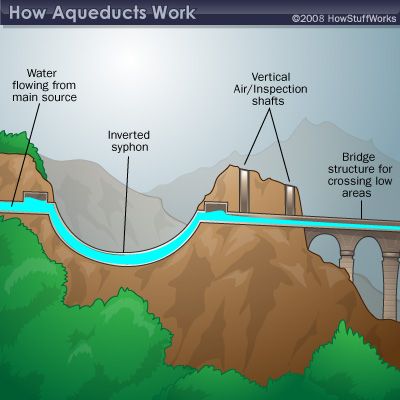
![]()
Roman cavalry mask, recovered from the
site
of the battle near Kalkriese,
(Battle of the Teutoburg
Forest - 9 AD)
in the early 1st century AD.
Photo via Museum und Park Kalkriese.
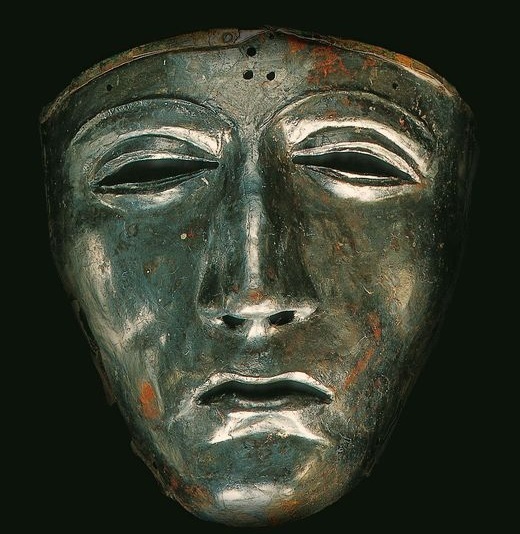
![]()
Scandinavian
rock carvings from Bardal in
Beitstad (Norway).

Right over the border in Sweden:
Swedish
Bronze Age rock carvings.
These are 3,000 years old.
"There are at least 1500 sites with these rock
carvings across the Northern Bohuslän region
of Sweden, each site with hundreds or
thousands of images."
Various images of the carvings
3.000 years ago, this area was one nation
and one culture.
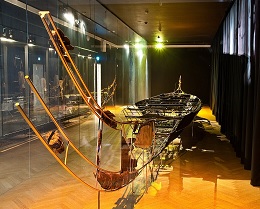
"The Hjortspring boat is a Pre-Roman
Iron Age war
canoe built between 400-300 BC. It is the oldest find
of a wooden plank-built ship from Scandinavia and
closely resembles the many Scandinavian Bronze Age
rock carvings depicting ships."
Bronze Age Rock carving from Tanum, Sweden
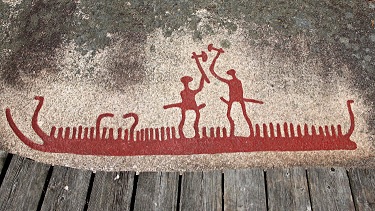
Spears from the Hjortspring boat
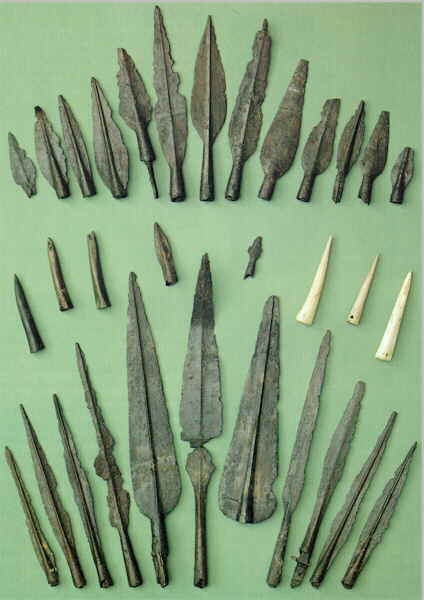
Credit: Early Medieval Europe Archaeology
Ancient Anatolia and modern Turkey occupy the same space on Earth
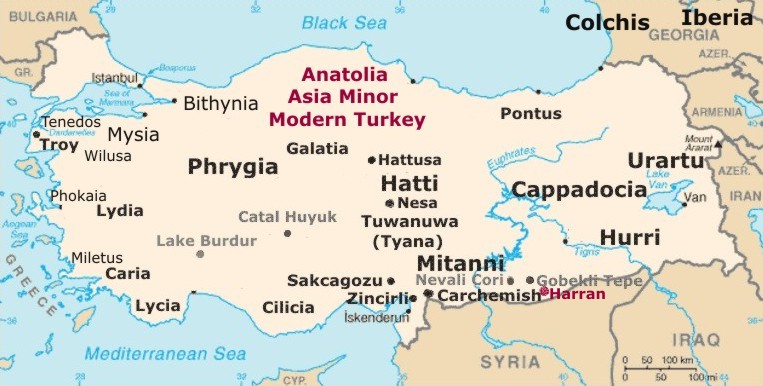
Here's a reference map of the ancient cities, kingdoms, and
archaeological sites inside the area, inside the borders of modern
Turkey. Learn more about the many peoples and complicated
ancient history of this region at Wikipedia
and Pinterest.
Ancient Astronomy of the North American Indians from the StarTeach Astronomy Education Program. Examples of astronomy as practiced by Native Americans of several different nations: the Anasazi and Pueblo peoples of New Mexico; Medicine Wheels in the Bighorn Mountains of Wyoming and many others in Alberta and Saskatchewan; Skidi band of the Pawnee Nation; and the Chumash in California.
 Ancient China from the
British Museum. Similar in layout to their Ancient Egypt and Mesopotamia sites.
Learn China's geography, its ageless traditions in arts and crafts, its 4,000
year old Shang Dynasty, the evolution of Chinese writing, tombs, filial piety
("ancestor worship"), and more. Each section has a Story to read,
a chance to Explore, and a Challenge (game). Very well done.
Ancient China from the
British Museum. Similar in layout to their Ancient Egypt and Mesopotamia sites.
Learn China's geography, its ageless traditions in arts and crafts, its 4,000
year old Shang Dynasty, the evolution of Chinese writing, tombs, filial piety
("ancestor worship"), and more. Each section has a Story to read,
a chance to Explore, and a Challenge (game). Very well done.
![]() Ancient
China on Pinterest This page is more than dozens of photos of terracotta
warriors. It has lesson plans, many complete teaching units, curriculum guides,
women's clothing through thousand of years, foot binding (ugh), money, customs,
inventions, abucus, art, government, machines, warefare, Great Wall, many
other things.
Ancient
China on Pinterest This page is more than dozens of photos of terracotta
warriors. It has lesson plans, many complete teaching units, curriculum guides,
women's clothing through thousand of years, foot binding (ugh), money, customs,
inventions, abucus, art, government, machines, warefare, Great Wall, many
other things.
Ancient Colosseum: A Virtual reality experience with Oculus Rift This 5 minute video concentrates on the atmosphere of structure and the place. The Colosseum was designed to impress the audience with its incredible awesomeness. The sound of the audience adds to the ambience.
Ancient Egypt This is the British Museum site, so it's quite good. Full of facts and well thought out. Hint: when you click on a subject link, a picture appears. You have to click on the picture to go to the actual link.
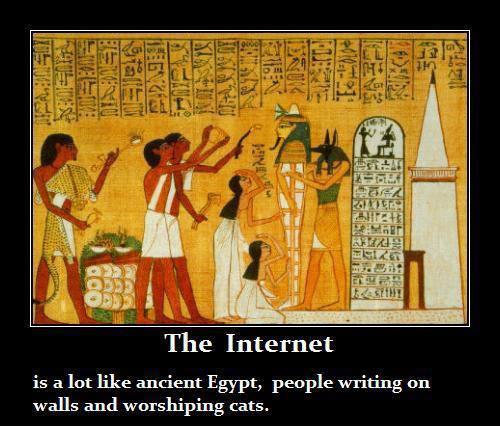
![]() Ancient
Egypt - Egyptian Interactive Activities from
Ancient
Egypt - Egyptian Interactive Activities from
Woodlands Junior School,Torbridge,
Kent, in the UK!
Amazing site from an amazing school. More kids computer
activities about ancient Egypt than we've seen anywhere!
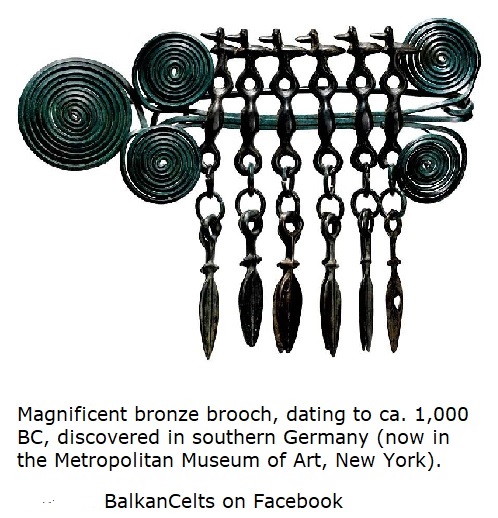
The Rosetta Stone is one of the most famous objects in the
British Museum.The stone is a broken part of a bigger stone slab.
it has a message carved into it, written in three types of writing.
It was an important clue that helped experts learn to read Egyptian
hieroglyphs, a writing system that used pictures as signs.
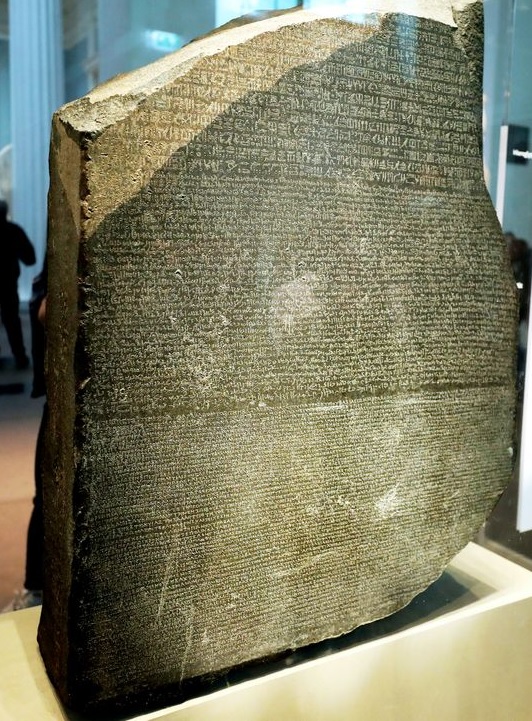
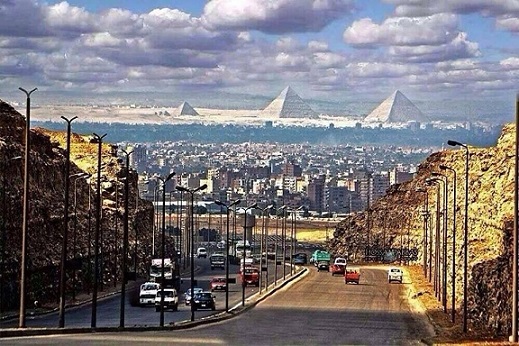
The Pyramids of Giza as seen from a street in Cairo, Egypt
Ancient
Egypt - Online Activities from The Royal Ontario Museum.
Covers everyday life, the arts, religion, mummies, who was who, writing,
jobs, much more.
 Ancient Egypt Online
"Welcome to Ancient Egypt Online; a site dedicated to the culture, language,
religion and history of ancient Egypt." Starting with very ancient times
(7,000 years ago plus). This site has a list of pharaohs (with biographies!)
stretching back over 3,000 years, from Cleopatra to Hor-Aha! The Scorpion
Ancient Egypt Online
"Welcome to Ancient Egypt Online; a site dedicated to the culture, language,
religion and history of ancient Egypt." Starting with very ancient times
(7,000 years ago plus). This site has a list of pharaohs (with biographies!)
stretching back over 3,000 years, from Cleopatra to Hor-Aha! The Scorpion
King Pharaoh is on this list. See if you can find him! Learn
to write hieroglyphics! Speak ancient Egyptian! Learn about all the different
gods and religions, and how they evolved over thousands of years. Explore
the monuments - tombs, pyramids, and temples. Learn about society and culture.
Find out what people ate, what they wore, how they accessorized, how they
partied! Check out their recipes. Go to the gift shop and buy ancient Egyptian
jewelry, perfume, incense, etc.; based on recipes written on temple walls!
You can also have translations of text from English into hieroglyphs. A LOT
of information here! Kudos to Jenny Hill, who made and maintains the site!
Seneb (left) with his wife Senites (right) and their children (below)
Sumeria Mesopotamia posted this on Facebook
· February 11, 2015 ·
Seneb was a dwarf who served as a high-ranking court official
in the Old Kingdom of Ancient Egypt, circa 2520 BC. Despite
his diminutive size, Seneb was a person of considerable importance
and wealth who owned thousands of cattle, held twenty palaces
and religious titles and was married to a high-ranking priestess
of average size with whom he had three children. His
successful
career and the lavishness of his burial arrangements are indicative
of the acceptance given to dwarfs in ancient Egyptian society,
whose texts advocated the acceptance and integration of those with
physical and mental disabilities. Seneb is depicted with his wife and
children in a painted sculpture from his tomb, rediscovered in 1926,
that is a famous example of Old Kingdom art. It shows him sitting
cross-legged on a block of stone with his wife embracing him and
his children standing below him where the legs of a full-size person
would ordinarily have been. Seneb is shown realistically with the
facial features and shortened limbs of achondroplasia, a common
form of dwarfism. Paintings and carvings in the tomb give his titles
and depict various scenes from his life, such as carrying out
inspections of his estate and holding symbols of his office.
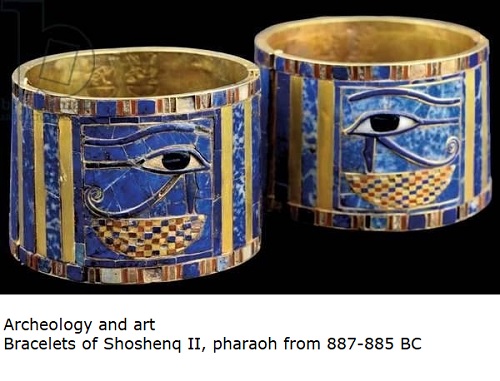
Anzud,
Sumerian god of storms
This stunning little pendant is made of real gold.
The blue parts are made of lapis lazuli from the
only mine they knew of in those days; way up in the mountains
of north Afghanistan on the border with China. The Indus Valley
people had a mine and a trading post up there. They loaded up backpacks
with lapis lazuli and walked back south across Afghanistan *, either back
to
their cities in the Indus Valley (the Punjab), or to a seaport they had on
the Indian Ocean. Trading ships from Ur and its sister cities could trade
for
things there and then sail back to their own lands.
* as time went on, people started using donkeys to haul trade goods,
instead of carrying the loads on their backs.
Sumeria Mesopotamia presents:·
"Anzud, the lion-headed eagle, the god of storms.
This pendant of gold and lapis lazuli is part of “The Treasure of Ur”,
although the name is misleading. Ur is a Sumerian city, but
the Treasure of Ur was found in Mari, which was an Akkadian city.
The pendant was found in a buried sealed clay jar. The jar contained
more than 100 items, including jewelry, cylinder seals, and statuettes."
excerpt credit = Sumeria Mesopotamia on Facebook
Sumeria
Mesopotamia
Sumerian Cloisonné Ring, Iraq, ca. 3000 BCE. (Louvre, Paris)
Cloisonné is an ancient technique for decorating metalwork objects,
in recent centuries using porcelain enamel, and in older periods also
inlays of cut gemstones, glass and other materials.

Be a scribe! Around 3,300 years ago in Egypt: "Beginning of the instruction in letter-writing made by the royal scribe and chief overseer of the cattle of Amen-Re, King of Gods, Nebmare-nakht for his apprentice, the scribe Wenemdiamun." The head scribe is giving a pep talk to his lazy apprentice: Learn to be a scribe and you will live well. Stop being lazy and get to work! Learn the work of the scribe. A classic quote: "But although I beat you with every kind of stick, you do not listen. If I knew another way of doing it, I would do it for you, that you might listen." Then the head scribe compares the job of a scribe to other jobs. " All Occupations Are Bad Except That of the Scribe. See for yourself with your own eye. The occupations lie before you." The work of the potter, the laundryman, night watchman, the merchant, the sailor, the ship's carpenter, the carpenter on a farm, (later) the peasant farmer ("The Misfortunes of the Peasant"), and the soldier ("The Scribe Does Not Suffer Like the Soldier"). All these professions are described in detail. " If you have any sense, be a scribe ...become one whom the king trusts; to make you gain entrance to treasury and granary. To make you receive the shipload at the gate of the granary. To make you issue the offerings on feast days. You are dressed in fine clothes; you own horses. Your boat is on the river; you are supplied with attendants. You stride about inspecting. A mansion for you is built in your town. You have a powerful office, given you by the king. Put these writings in your heart, and you will be protected from all kinds of toil. You will become a worthy official."

Who
Invented the Alphabet?
Smithsonian article. Travel back in space
and time to the Sinai in 4,000 BC!
"Centuries before Moses wandered in the
'great and terrible wilderness' of the Sinai
Peninsula, this triangle of desert wedged between
Africa and Asia attracted speculators, drawn by rich
mineral deposits hidden in the rocks.
And it was on one of these expeditions, around 4,000
years ago, that some mysterious person or group took
a bold step that, in retrospect, was truly revolutionary.
Scratched on the wall of a mine is the very first attempt
at something we use every day: the alphabet."
Another site argues that
Egyptian scribes invented
this writing to communicate with the miners from
Canaan who came to the turquoise mines, and it has
examples of the alphabets.
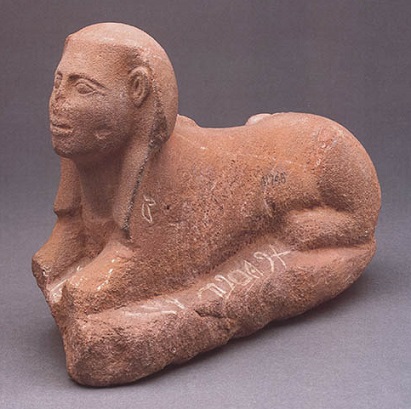
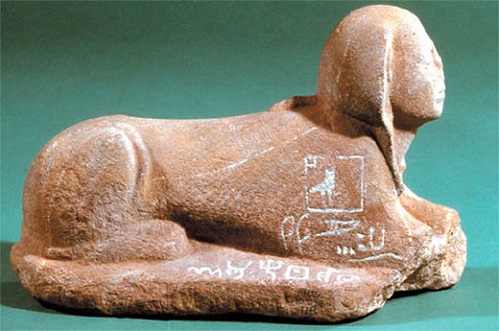
The Minoan civilization of early Bronze Age Greece. This is
a mural from Akrotiri,
on the island now called Santorini. The mural shows the thriving city and
seaport.
The two biggest known trade crossroads of Minoan civilization were Akrotiri
and
the cities of Crete.
Akrotiri sat on top of a huge volcano named Thera. About 1650 to 1600 BC
(3,600 years ago) Thera erupted. This mega-eruption and its 35 to 150 m
(115 to 492 ft) high tsunamis destroyed Minoan towns all over the area,
including on Crete. That was the end of the Minoans.
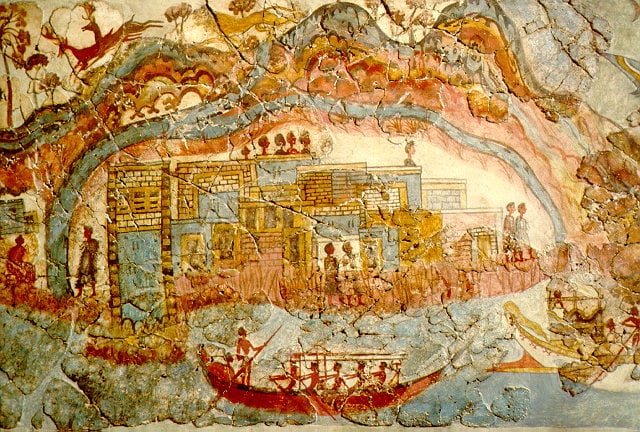
Ancient Greece
from the British Museum. Wonderful! For grade six and up, we think.
Lets students explore and learn with good graphics, games, activities, plenty
of facts.
Teachers should visit the Staff Room before using the site, and should also
check
this site out first. British Museum gets a vote of thanks for this.
Ancient Greece Lesson Plans and Ancient Greece Graphic Organizers and Worksheets from Curriki "Collection of lesson plans for teaching topics of Ancient Greece. Topics such as the Greek gods, government and culture." and "Collection of graphic organizers for teaching topics of Ancient Greece. Topics such as Greek gods, their city-states and government as well as the overall impact of Ancient Greece." Designed, they say, for grades 3 -10.
Ancient Greeks from BBC Primary History - one of many great sites from them! Find out all about the ancient Greeks. Play Greek Hero and have adventures! Fun and educational.
 GREECE
- ancient art wasn't black & white All those white statues! Guess
what? When they were new they were bightly colored! 2,000+ years out in the
weather scrubbed off the paint. Scientists have found traces of color, though.
Now you can see computer art of statues in all their original glory! This
7:30 video is a survey of some of the best known sculptures.
GREECE
- ancient art wasn't black & white All those white statues! Guess
what? When they were new they were bightly colored! 2,000+ years out in the
weather scrubbed off the paint. Scientists have found traces of color, though.
Now you can see computer art of statues in all their original glory! This
7:30 video is a survey of some of the best known sculptures.
Ancient History the BBC site. Wonderful! This extensive site covers ancient: Egypt, Greece, Rome, Britain, Anglo-Saxons, India, Vikings, and more! Another great BBC ed site.
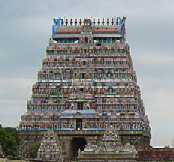 Ancient India from the
British Museum. Similar in layout to their Ancient
Egypt and Mesopotamia
sites. Learn about religion, geography, writing, legends, the wheel of time!
Teachers: pair this with Water
for Sixth Graders - Ancient India--British Museum Style. It's a premade
lesson plan that draws on the British Museum
site! It also has a lot of links.
Ancient India from the
British Museum. Similar in layout to their Ancient
Egypt and Mesopotamia
sites. Learn about religion, geography, writing, legends, the wheel of time!
Teachers: pair this with Water
for Sixth Graders - Ancient India--British Museum Style. It's a premade
lesson plan that draws on the British Museum
site! It also has a lot of links.
This statue (a moai) from Easter Island (Rapa Nui)
proves there is more to a moai than just the head!
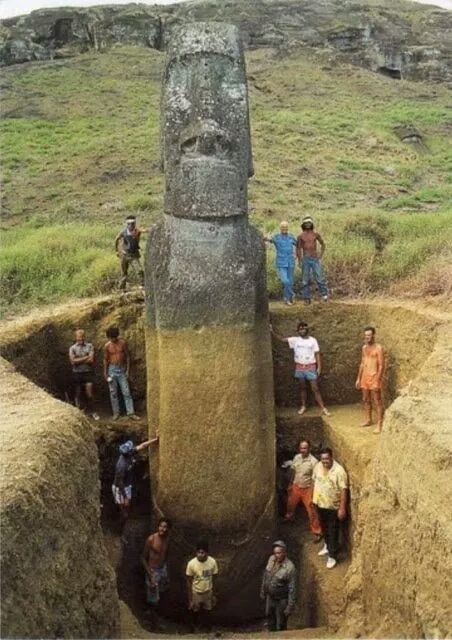
Ancient Rome Enormous site covering
anything students or teachers could need to know about Rome and the Romans.
Their A - Z content page has 70 different topics links to click. Art, aqueducts,
baths, roads, emperors list, slaves, women's status, the military, trade,
society, gladiators, tattoos, everything! One example: The section on roads
is very detailed with plenty of graphics. You learn enough to make one yourself,
were you so inclined. Way too much to tell about. If you want to know something
about Rome for any K-12 class, it is in here.
Ancient Rome for Kids from
Mr. Donn. Anything K-12
students would want to know about Rome and the
Romans IS in this site! Enough said.
Ancient Rome for Kids - Free Games and Activities
from Mr. Donn. Big list of fun games and activities.
Ancient Romans from BBC Primary History - one of many great sites from them! Find out all about the ancient Romans. Dig up the past in the Dig It Up: Romans game! Fun and educational. Several pdf activities for teaching, also.
Here are two sites about young people in ancient Rome:
Four sisters in Ancient Rome "How did the young, wealthy women of Ancient Rome spend their days? Meet Domitia and her sister Domitia and her sister Domitia and her sister Domitia. Ray Laurence sketches the domestic life of leisure that these young girls lived, despite little recorded information on women from this otherwise well-documented era." A good video is followed by a quiz and chances to learn more. Young poor women likely lived similar lives; but with less bling, more work, and more babies.
A glimpse of teenage life in ancient Rome "Welcome to the world of Lucius Popidius Secundus, a 17-year old living in Rome in 73 AD. His life is a typical one of arranged marriages, coming-of-age festivals, and communal baths. Take a look at this exquisitely detailed lesson on life of a typical Roman teenager two thousand years ago." A good video is followed by a quiz and chances to learn more.
Iron slave collar, Roman, fourth-sixth century CE. The inscription says "I have run away; arrest me. When you return me to my master, Zoninus, you will receive a gold coin."
![]() Ancient Web
includes information about 44 ancient civilizations worldwide! It's about
time these were all in one place for kids. Well done and often in-depth. Where
else can you find information on ancient Poland and the ancient Philippines?
Amazing site!
Ancient Web
includes information about 44 ancient civilizations worldwide! It's about
time these were all in one place for kids. Well done and often in-depth. Where
else can you find information on ancient Poland and the ancient Philippines?
Amazing site!
Anglo-Saxons is one of the best of the new BBC "ancient" sites for kids, that we've seen thus far. Comprehensive, covers everything kids would want to know about these "Anglish" people. The Fun Facts are interesting and relevant. Play the "Hild and the village feast" game for a sort of virtual tour. Dig up the past in the Dig It Up: Anglo-Saxons game. There is a pdf file of activities for this lesson also.
Archaeology the BBC site. Good overview of the subject with emphasis on Britain. Good coverage of battle field, aerial, and underwater techniques.
Archaeology for Kids from the National Park Service (NPS.) May be the best American intro site for kids. Very good site covers different branches of archaeology, tools, how to dig, lesson suggestions, how to become an archaeologist, more.
Stone carving of a bull aurochs from Grotta
del Romito, southern Italy.
Aurochs are the ancestors
of modern cattle. Big as an American bison,
aurochs had distinctive curved horns.
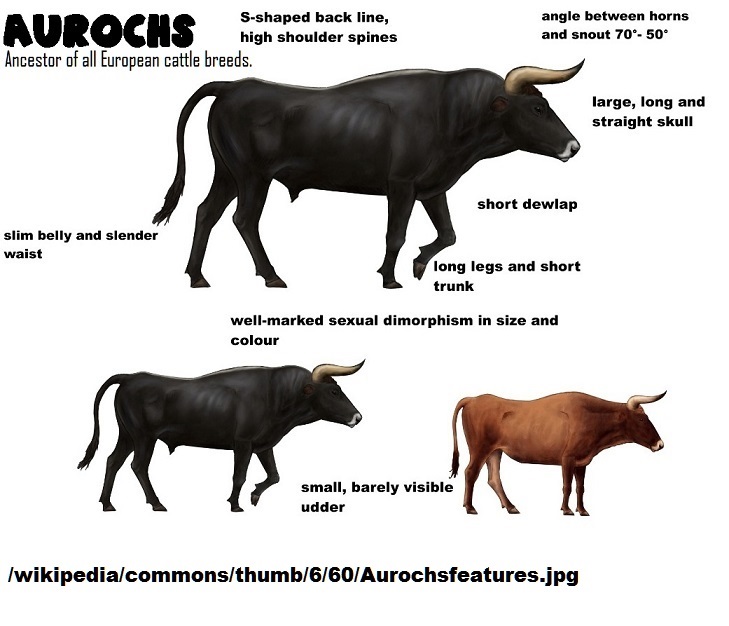
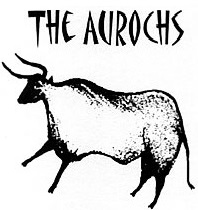

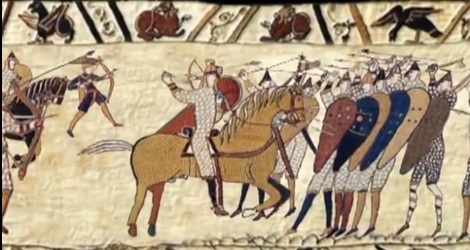 The
Bayeux Tapestry
from mrdonn.org. It's part of his awesome Middle
Ages for Kids section. Students will find out (a) what a tapestry is,
(b) who made this tapestry, (c) why this tapestry is important, (d) what the
tapestry tells us about this battle of 950 (about) years ago. There are also
plenty of links to videos, activities, PowerPoints, graphics, etc., including
the excellent video Bayeux
Tapestry - Animated Version
The
Bayeux Tapestry
from mrdonn.org. It's part of his awesome Middle
Ages for Kids section. Students will find out (a) what a tapestry is,
(b) who made this tapestry, (c) why this tapestry is important, (d) what the
tapestry tells us about this battle of 950 (about) years ago. There are also
plenty of links to videos, activities, PowerPoints, graphics, etc., including
the excellent video Bayeux
Tapestry - Animated Version
Bible Places "features photographs and descriptions of sites in Israel, Jordan, Egypt, Turkey and Greece with an emphasis on biblical archaeology, geography and history." Despite its name, this site is not overtly religious. Go to the left-hand menu. In "The Sites" section are very good photo tours of dozens of different archaeological sites. We've done a lot of ancient Egypt with kids. This site fits in just fine.
This small carving of a water bird was created
33,000 years ago.
The sculpted piece of mammoth ivory, found in the Hohle Fels
cave,
in Germany, may be the earliest representation of a bird.

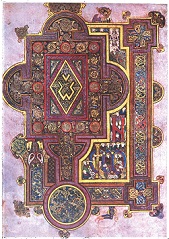 The Book
of Kells Online The Book of Kells is a precious and glorious hand-written
illuminated
manuscript of the Four Gospels, in Latin. It was written around 800, maybe
earlier, by Irish monks at a monastery on the Isle of Iona, Scotland. The
pages are made of vellum (prepared calfskin). It was moved to Ireland to get
it away from Viking raids. Yes, students, it is that old. Learn more of its
history
here. Now you can scroll though and look at each of the 340 pages. You
don't have to read Latin to enjoy the enchanting, mystical art on every page.
You can zoom in on every little detail. It gets even better! If you have an
iPad, there's an app for this!
The Book
of Kells Online The Book of Kells is a precious and glorious hand-written
illuminated
manuscript of the Four Gospels, in Latin. It was written around 800, maybe
earlier, by Irish monks at a monastery on the Isle of Iona, Scotland. The
pages are made of vellum (prepared calfskin). It was moved to Ireland to get
it away from Viking raids. Yes, students, it is that old. Learn more of its
history
here. Now you can scroll though and look at each of the 340 pages. You
don't have to read Latin to enjoy the enchanting, mystical art on every page.
You can zoom in on every little detail. It gets even better! If you have an
iPad, there's an app for this!
The British Isles From 43 AD To 2016 AD 7:33 video, actual title: Animation Presents The History Of The British Isles From 43 AD To 2016 AD. From Realm of History. It's great and the whole page it is on is great, too.
The Buffalo Chasers An article from Archaeology, by Eric A. Powell. "Vast expanses of grassland near the Rocky Mountains bear evidence of an extraordinary ancient buffalo hunting culture." An excellent introduction to the subject. One 20 mile stretch on one reservation has 11 known buffalo jumps. Archaeologists now believe there was a highly organized society behind these "industrial scale" sites. Tribes could get enough meat and other products to get through the winter or longer. There was often a surplus that could be traded around the Plains. The article has several photos and plenty of information, both from Native people and archaeologists.
Butser Ancient Farm is actually a group of sites, about an British Iron Age farm and a Roman villa later built at the same place. Learn about ancient British buildings, what crops they planted, and what animals they raised. There are pix of the animals. Unique and very informative.
CMA Kids Ancient Egypt A work in progress, this site boasts playable online games of Senet and Hounds & Jackals. Also art projects, information on mummies, pyramids, more. From the Cleveland Museum of Art.
Cahokia Mounds official site. (new url) Learn about the largest mound complex north of Mexico and the cradle of the Mississippian Culture. The Legends of America Cahokia Mounds site(new url) has additional information. The Washington Post has an online educational article with yet more Cahokia goodies here. The National Park Service has a small web page about Cahokia with more info and a nice picture of the temples in their prime.
Castles on the Web "offers an extensive database of all things Castle related including a castle photo gallery, free castle web pages, hundreds of castle links, castle site of the day, castles for kids and more!" For our favorite trio of (then) 10 year old castle freaks, and a few million more like them.
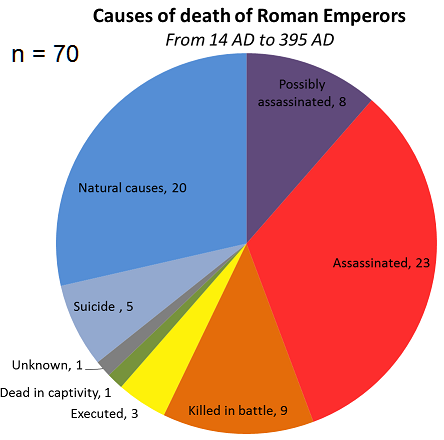
Chauvet-Pont-d'Arc
Cave This French cave was only discovered in 1994. It's famous
for its paintings of dangerous animals such as cave bears, lions, hyenas,
and mammoths, to name a few. Also famous for human footprints, animal bones,
and a cave bear skull mounted on a rock!.
VIRTUAL TOUR: Inside Chauvet Cave
| Google Arts & Culture
Chauvet cave: Preserving prehistoric art
- BBC News
Christmas in the Middle Ages "This feature looks at the origins of Christmas and how it was celebrated in the Middle Ages. It includes links to articles related to this topic." Three short videos discuss Origins, What went on at Christmas, Christmas Plays, Christmas Carols. Each has a short text of the same name. Excellent videos! There's also a section about Christmas trees, and some good links at the end.
Dendrochronology from the US National Park Service. This interactive presentation of tree ring dating for Webrangers is quite good. Like Tree Ring Analysis, this is a fine lesson on tree ring dating. Part of a larger site.
Derinkuyu & The Underground Cities of Cappadocia
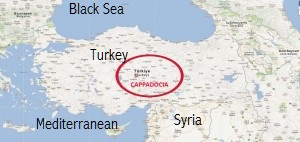
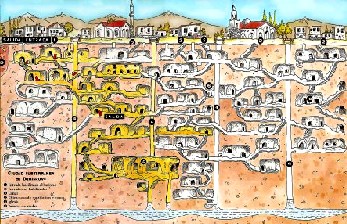
Learn about mysterious ancient underground cities! Located in Turkey, these places were dug in ancient times starting during the time of the Pharaohs of Egypt. Two charts and plenty of photos accompany this page.
DIG the online archaeology magazine for kids! Big site about archaeology. We really liked Ask Dr. Dig and all the links from there. The home page's list of links is another great resource.
Dig It Up: Romans from BBC Primary History - Four levels of archaeological
adventure await students who are helping excavate a dig before it gets paved
over! Intro video at the start shows kids what to do. Develops an appreciation
of what's involved in digs (precise, careful, but hard, work). Also, it's
cool when you find something! Does not have its own URL, it's a Flash child
of the main page. Dig
It Up: Anglo-Saxons and Dig
It Up: Vikings are similar and similarly good.
Digital Karnak Ancient Egyptian temple complex. "The colossal site of Karnak is one of the largest temple complexes in the world...We invite you to experience Karnak – to learn about an ancient site that still resonates today because of its monumental pylons, towering columns, stunning reliefs and architectural marvels. Enter the temple precinct and discover its rich religious, political and architectural history." Fantastic site! Use the Time Line to see the temple area being added to over centuries. Download a KML file of the temple in its glory days and run it on Google Earth. Browse Archive has more data on ancient Egypt than you'll ever see in one place again. Experience Karnak has videos and animations - our favorite is Animations of the Temple Model that lets you fly through the temple complex. Developed by UCLA's Experiential Technologies Center.
* For all KML files: download to computer, then do file>open from inside Google Earth. When you close Googe Earth, click Yes when it asks if you want to save the temp file to your permanent files.
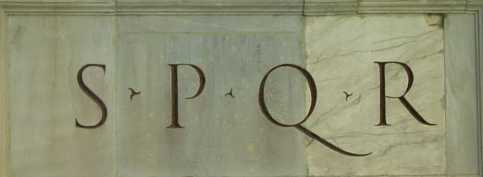 Digital
Map of the Roman Empire HUGE map lets you zoom way in and way out!
See the network of road, the names and borders of the provinces, zoom in on
the smallest village mentioned in history, and the tiniest island. See where
towns and forts were (modern place names are in italics). Click "About
this Map" to see the map's Legend
(what the symbols mean).
Digital
Map of the Roman Empire HUGE map lets you zoom way in and way out!
See the network of road, the names and borders of the provinces, zoom in on
the smallest village mentioned in history, and the tiniest island. See where
towns and forts were (modern place names are in italics). Click "About
this Map" to see the map's Legend
(what the symbols mean).
Dome of the Sky Lists constellations by northern and southern hemispheres and time of year. Has an outline of each constellation and the story or myth behind it. Good resource.
Early British Kingdoms for Kids (Part of David Nash Ford's Early British Kingdoms Website, please click here to learn more.) Kids will learn about Britons, Picts, Romans, Saxons, Scots; about Roman Britain, how the different peoples lived, farmed, their food, homes, and forts. They will learn about famous kings like Arthur, Offa, and Vortigern; the religions, minstrels, runes, hoards/buried treasure, armor, weapons, Beowulf, the Sutton Hoo ship, and MUCH more! Plenty of activity sheets on offer, too.
Eastern Mound at Karanovo from the FB Sumeria Mesopotamia Community
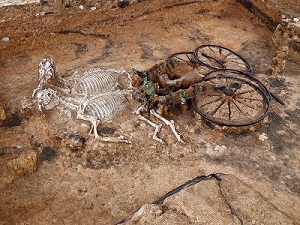
"Eastern Mound at Karanovo. Thracian
aristocrats went down the road to death riding their favourite chariot, with
their favourite hunting dog running around. And it was quite literal. Archaeologists
often find dogs and horses still in their harnesses pulling a chariot –
slain and buried along their dead masters.
Until recently, the awe of stumbling upon a buried Thracian
chariot was for two kinds of people, archaeologists and treasure-hunters.
It all changed in 2008, when a group of archaeologists began excavations at
the Eastern Mound in a Thracian necropolis at Karanovo, near Nova Zagora.
Treasure-hunters were the first to dig there, but they somehow missed the
chariot they were after (a Thracian chariot on the international black market
is very expensive). The skeletons of two horses were still harnessed in the
chariot, and a slain hunting dog lay nearby. Excavations also revealed other
precious artefacts*, like a rare silver cup with dancing Eroses, and a glass
rython in the form of a snail. The tomb dated back to the 1st Century AD.
Unlike so many Thracian sites that hit the news and are then abandoned to
the elements, the Eastern Mound was lucky. In 2010, its content was conserved,
with the chariot and the animal skeletons left in situ. [* "Artefacts"
is the British Commonwealth spelling, ie, the whole English-speaking world
except the USA. The US spelling is "artifacts".]
Educational
games from Digipuzzle.net.
"On this page you can find the overview of the educational games from
Digipuzzle.net. All games can be played full screen on a PC, a tablet (Android
Tablets, iPad, etc) or mobile phone (Android, iOS)." Here's a diverse
group of kids' games, from numeracy to multiplication, with some early language
arts, some geography, time, hieroglyphics, and
some money math. Here they are by subject with the number of games in parentheses:
A big Thank You to Marcel van de Wouw. These are nice!
Explore Ancient Egypt from PBS/WGBH/NOVA "Want to walk around the Sphinx? Clamber inside the Great Pyramid of Giza and seek out the pharaoh's burial chamber? Visit the magnificent tombs and temples of ancient Thebes? In this multi-layered, highly visual interactive, view 360° panoramas, "walkaround" photos, and other breathtaking imagery shot throughout the Giza Plateau and ancient Thebes (modern-day Luxor), often with special permission. You'll see Old and New Kingdom tombs and temples, pyramids and statues, and a 140-foot-long wooden boat that is 4,600 years old. Enjoy this unique journey through the Land of the Pharaohs."
![]()
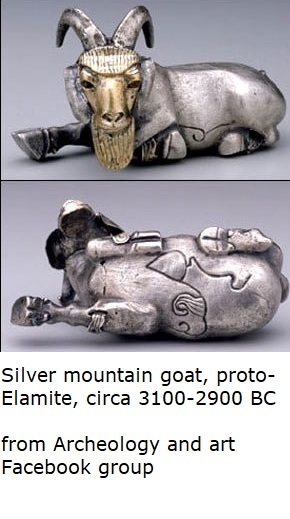
First Peoples' Buffalo Jump State Park in Montana. One page description of a typical buffalo jump, that is still considered sacred to this day. Plenty of photos of the jump, and a short blurb about the Metis people of the Red River Valley (Manitoba, Minnesota, and North Dakota).

Hey! How'd that horse get in there?
This was way before horses!
Men with any sense would not ride their good war horse next to a cliff, anyway!
"Batter Up!" What's with this guy swinging a fence post?
Gifts
of the buffalo. This graphic lists many of the gifts.
Not everything is listed, but the People used everything.
Waste not, want not.
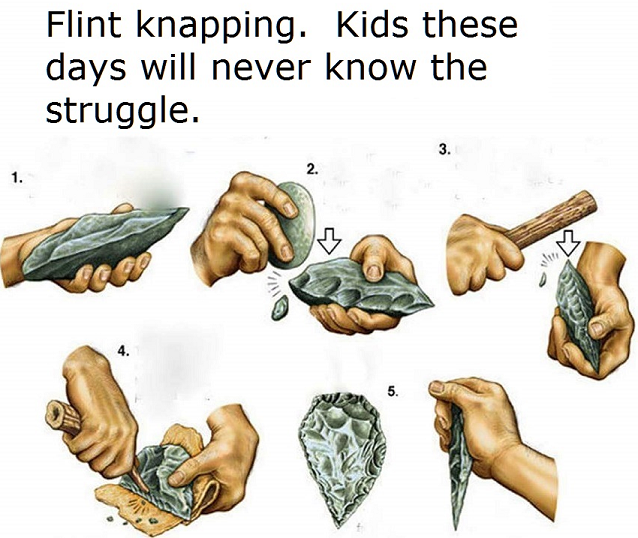
Freya amulet/charm/figurine
"The small figurine of Freya.
A newly discovered female figurine amulet from Revninge
in the east of Denmark represents a very interesting find due to her remarkably
detailed
Viking Age dress. This small gilt silver figurine contains a wealth of detail
giving new
knowledge about costume and jewelry of the period."
Cite: Viking Age Revninge woman: an exceptional find. Past Horizons. June
2, 2014, from http://www.pasthorizonspr.com/index.php/archives/06/2014/viking-age-revninge-woman-an-exceptional-find
Click on the photo below to see the view from the top of the Pyramid of Khufre!
 Giza 3D from
Dassault Systemes. Go to Egypt and see the Pyramids of Giza as they looked
when they were new, 4,500 years ago! Explore it all in interactive 3D! Take
narrated 3D guided tours. Explore pyramids, temples, tombs, art, carvings,
statues, furniture - "wonderful things"! You will have to download
and install the 3DVIA Player plug-in from the site (it's safe). Don't forget
to scroll down the first page, and
run the intro video there.
Giza 3D from
Dassault Systemes. Go to Egypt and see the Pyramids of Giza as they looked
when they were new, 4,500 years ago! Explore it all in interactive 3D! Take
narrated 3D guided tours. Explore pyramids, temples, tombs, art, carvings,
statues, furniture - "wonderful things"! You will have to download
and install the 3DVIA Player plug-in from the site (it's safe). Don't forget
to scroll down the first page, and
run the intro video there.
Gobekli
Tepe - A 12,000 year old place of worship. Built by hunter-gatherers using
stone tools. No metal tools. No farming.
Göbekli
Tepe’s Oldest Temple in the World is a site that gets technical
about the place. Most of us are in awe about how Stone Age hunters put it
all together. The vistas must have been spectacular. World’s
First Temple is a small site that supports a one hour + video about the
discovery of this 12,000 year old sanctuary.
This site is full of information;
it digs deep into the temple idea.
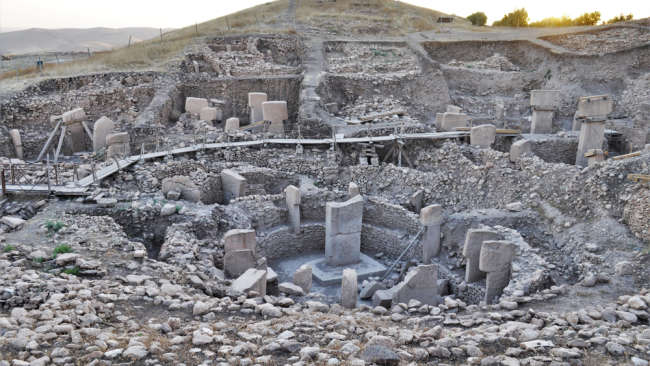
World's
"Earliest-Known Temple" Built
11,500 Years Ago With
Geometry in Mind
11,500 years old. Before agriculture. Before farming, gardening, before
domestic farm animals, before metal tools. They laid it out using math!
Greek Gods and Goddesses A new retelling of the principal dieties for students. "GreekGodsAndGoddesses.net (GGG) was created in 2012 to provide an informative, easy to follow, and attractive online resource for information on the Olympian gods in Greek mythology... From K-12 students to mythology enthusiasts, GGG offers anyone interested in the Olympian gods an opportunity to enjoy learning about them." The site will be expanded in future to include more bios and facts about other figures in Greek Mythology. Go to this site and enjoy it! Thanks to Joshua for the email!
Greek Myths from Kidepede "Here are some of the myths - stories about the gods and heroes - that Greek people told" 30 myths listed, each with its own page.
 Hadrian's Wall -The
Complete Story @1080p 48 minutes of learning about the 74-mile Wall -
where it is, when it was made, who built it, the history, Roman army life,
account books, soldier's wives, construction, religion, and wonderful scenery!
A good Wikipedia article here.
Hadrian's Wall -The
Complete Story @1080p 48 minutes of learning about the 74-mile Wall -
where it is, when it was made, who built it, the history, Roman army life,
account books, soldier's wives, construction, religion, and wonderful scenery!
A good Wikipedia article here.
Hadrian's Wall from BBC Primary History - Romans One page of a larger section, with photos and videos.
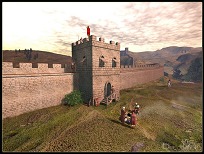
Hadrian's Wall - Good Sites for Kids' own page about Hadrian's Wall and the Antonine Wall. Plenty of images, too.
Hadrian's Wall Gallery A gallery of 12 photos of places along Hadrian's Wall, with commentary for each photo. From BBC History > Ancient History.
Hair Archaeologist Professional hairdress Janet Stephens of Baltimore is an expert in ancient Roman hair styles. As a working hairdresser, she brought her experience and knowledge into this area of study. "A hairstylist by day, Janet Stephens has become a "hair archaeologist" studying the intricacies of ancient Greek and Roman hairstyles. As WSJ's Abby Pesta reports, she's been published in the academic community on her research, which she says proves the intricate hairstyles were not wigs." Now she recreates ancient Greek, Cleopatra's, ancient Roman (including Vestal Virgin style), Medieval, Renaissance, 18th century French (Papillote Curls), Victorian, American Civil War period, and more. Her YouTube channel is full of video tutorials on how to do these "do"s. See the next site down for more!
![]()
This small carving of a water bird was created 33,000 years ago.
The sculpted piece of mammoth ivory, found in the Hohle Fels cave
in Germany, may be the earliest representation of a bird.

Hegra,
an Ancient City in Saudi Arabia Untouched for Millennia,
Makes Its Public Debut
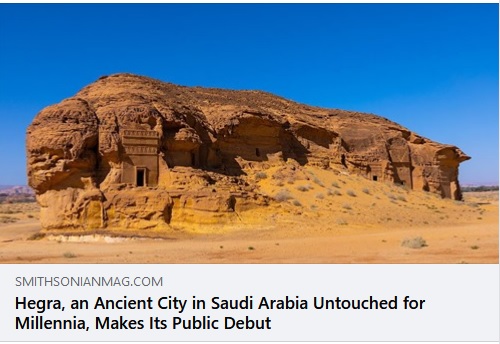
The "Second City" of the Nabateans, after Petra.
Homer’s Odyssey Sung In Original Ancient Greek "In the course of the last years, we have developed a technique of singing the Homeric epics, which is appropriate for the primarily oral tradition from which these poems emerge." Accompanied by an ancient type of lyre. Fives minutes of pretty monotonous recitation, but it's really Homer, sung in Ancient Mycenean (aka archaic Greek).
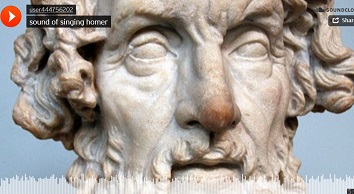
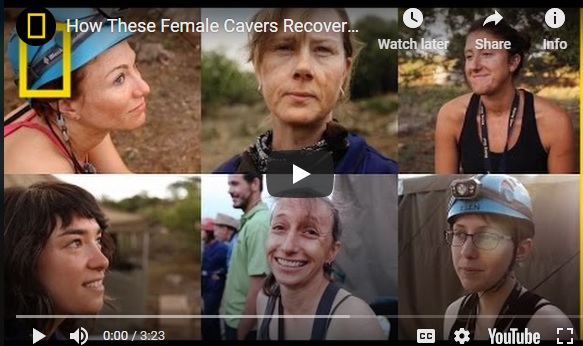
How These Female Cavers Recovered New Human Ancestor Fossils
Deep within a cave in South Africa, more than 1,200 individual bones of a
new
human ancestor, Homo naledi, were discovered. To recover the bones, six
archaeologists had to rappel down underground shafts and squeeze through
rocky passageways as narrow as 18 centimeters (8 in). The call went out and
all the small, tough, and limber athletes who qualified - were women.
How
to have a Medieval Hairstyle (video) Janet Stephens, one of the
world’s leading experts on historical hairstyles, has released a medieval
hairdressing tutorial, based on a 1328 painting by Simone Martini in Siena.
The famous "hairstyle archaeologist" goes step by step through the
process of creating this cute arrangement.
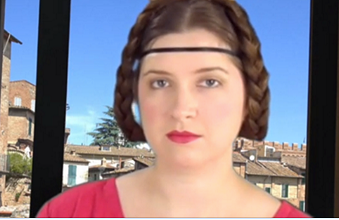
The Hanging Gardens of Babylon
(Article title = Breathtaking Animation Presents A Reconstruction Of The Hanging Gardens Of Babylon) This was one of Herodotus’ Seven Wonders of the Ancient World. "The folks over at Lumion 3D have given a go at virtually reconstructing this monument from antiquity – and the results are quite breathtaking to say the least". Three-minute video.
Head-Smashed-In
Buffalo Jump, a UNESCO World Heritage Site. This is a saveable pdf file.
"In 1981, the United Nations Educational, Scientific and Cultural Organization
(UNESCO)
designated the jump as a World Heritage Site, placing it among other world
attractions such
as the Egyptian pyramids and the Galapagos Islands." That's a pretty
big deal.
Great graphics, good explanations, and readable. All is explained.
History of the Roman Colosseum 10 minute video quickly covers the history, starting with Vespasian's desire to replace Nero's vast "Golden House" complex with something for the people. Construction, layout, the retractable top, stairs, elevators, and restaurants! The early Coliseum was regularly flooded so that sea battles could take place. Nero's "plumbing" - tunnels for filling and draining - are explored. The Hypogeum was built later. All the Colosseum's fascinating parts are examined, even the elevators.
History for Kids! is now Kidepedia History , look below.
How Tree Rings Reveal Climate Secrets (Infographic) "Scientists can determine a lot about past climates by taking core samples from trees that have lived for hundreds or thousands of years. The study of a tree’s rings is called dendrochronology."

Source:LiveScience
Human History of the Colorado Plateau "The prehistoric people of the Colorado Plateau, the so-named Ancestral Puebloans, lived here for well over a thousand years. While the geology and scenic beauty and diversity of flora and fauna compliments the territory's featured assets, the achievement and cultural advance of these people is noteworthy." This site's an overview of the people, how they endured over time, their changing culture, their agriculture, their changing architecture, the kivas, Chaco Canyon, and the 21 present Pueblos. There's a big section for tourists of all ages on what not to do called "ARCHEOLOGICAL RULES OF THE ROAD". Please read it and remember it. BTW there are LOTS of photos and paintings to let you see all this wonder!
Imperial History of the Middle East "Who has conquered the Middle East over the course of world events? See 5,000 years of history in 90 seconds..." This is a Flash file, so it's like watching a video.
Inca Empire for Kids from Mr. Donn's Ancient History Page, which is further down on this page. Everything you need to teach an Inca unit. Tons of cool info for kids, and a ready-to-go unit for teachers. There are a lot more like this on Mr. Donn's site, so check it out!
 Indus
Valley from BBC
Primary History Go back in time 5,000 years and explore the Indus Valley
civilization! Learn about who they were, how they lived, what they ate, their
cities, jobs, writing, business, everything! Play the Indus trader Game! Become
an Indus Trader and explore the ancient cities,
then prepare to sail to Sumer!
Indus
Valley from BBC
Primary History Go back in time 5,000 years and explore the Indus Valley
civilization! Learn about who they were, how they lived, what they ate, their
cities, jobs, writing, business, everything! Play the Indus trader Game! Become
an Indus Trader and explore the ancient cities,
then prepare to sail to Sumer!
Indus Valley from the British Museum. Part of their great Ancient India site. Investigate Mohenjo-Daro, check out pottery, and read the story of life in a bead maker's shop (just like in Indus Trader). Then go see the rest of the main site.
The Internet Classics
Archive from MIT. "Bringing the wisdom of the classics to the Internet
since 1994. Select from a list of 441 works of classical literature by 59
different authors, including user-driven commentary and "reader's choice"
Web sites. Mainly Greco-Roman works (some Chinese and Persian), all in English
translation. Construct powerful queries to search the texts provided locally
and remotely. Search by work and author, as well as the entire archive."
Search for words or terms, too. Read works such as Homer's Iliad
and Odyssey online,
for example, and/or download the entire work in plain text format (.txt).
Example: Search for the term "Myrmidon"
(Achille's warriors)
Search results shown below:
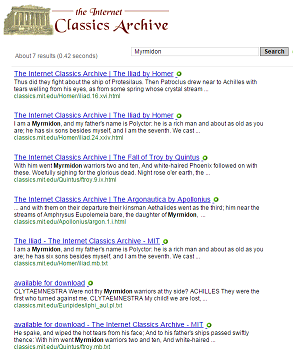
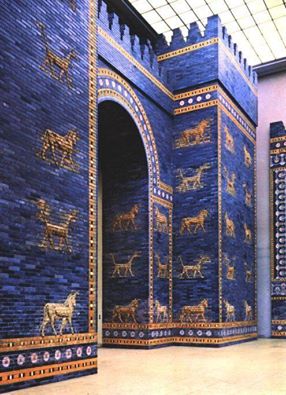 The Ishtar Gate
of Babylon - Rebuilt at the Pergamon Museum in Berlin.
The Ishtar Gate
of Babylon - Rebuilt at the Pergamon Museum in Berlin.
The beautiful deep blue color of the original gate came from lapis
lazuli,
a semi-precious stone mined in far northern Afghanistan.
Journey of Mankind
- The Peopling of the World. Interactive Flash map lets you follow the migrations
of humans over the last 160,000 years! Plenty of places to click to get more
information, too. Very impresssive, with sound effects (Toba Volcano). Lays
it all out for students right on the computer screen!
These next
two sites deal with the
Battle of Kadesh and the Treaty of Kadesh,
over 3,000 years ago:
The Battle of Kadesh and the First Peace Treaty An article by Joshua J. Mark in the Ancient History Encyclopedia. Covers the background, the why, where, who, and what happened (without going into agonizing detail), and the results. The Hittites held onto the city but lost a big piece of their army, enough to stop any plans to keep fighting. The Egyptians lost a big piece of their army, and went home. Basically it was a draw. This fiasco resulted in the Treaty of Kadesh some years later. Both leaders (1) agreed to make peace, and (2) pledged mutual defense - if an enemy attacked either, the other would send help. Copies of this treaty from over 3,000 years ago still exist, in Hittite cuneiform and in Egyptian hieroglyphics.
The Treaty of Kadesh in English from Language and Law.org, for those who want to know more. The Hittite copy of the Treaty was written on silver plates which were then sealed inside clay envelopes, which also had the text of the Treaty written on them. Even though the clay tablet had the words of the treaty, the silver tablet inside was the actual legal treaty. That's how they did things in ancient Mesopotamia, go figure. That's why the clay tablets were broken open by looters when the Hittite capital was destroyed by fire. Part of the clay envelope is still around. The silver plate inside is long gone. The Egyptians did not have this problem - no one is going to steal a stone temple wall!
Kidepedia History Formerly History for Kids! - same site, new name, more stuff. Covers most of the world from ancient times up through the 1700s. You have to dig a little - for instance, ancient Japan is in Chapter Thirteen- Asia In The Middle Ages. Good coverage with lots of information and pics to keep kids interested.
Knossos,
The Ancient Palace Stronghold Of The Minoans
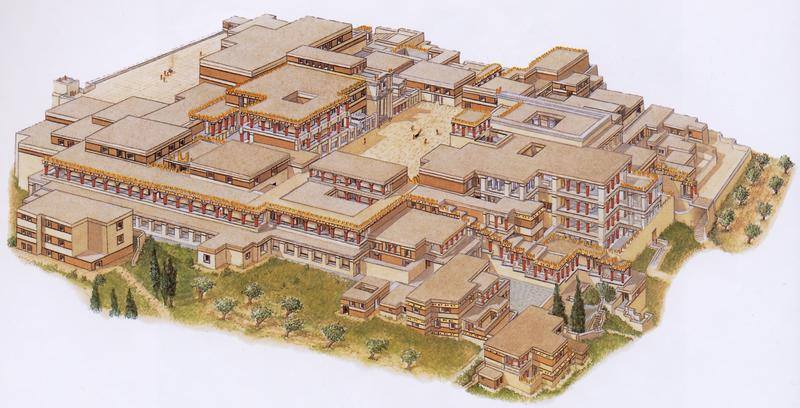
Three different video tours of this sprawling establishment.
The history is also explained, in a long but good article.
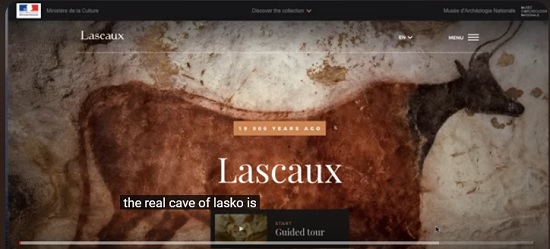
 Lascaux
Cave The Cave of Lascaux is the French government's site (mostly in English)
about this stone age cave and its world famous paintings. Click HERE
to tour the cave at the
updated Virtual Visit , which lets you explore the cave section by section,
with closeup Flash pix of the paintings (click the orange letters "en
savoir" to do this) and detailed explanations. You may also want to click
on the white labels that periodically appear. Eerie music accents this amazing
experience. Everyone ought to visit this site at least once. Also see the
Chauvet Cave page which is also in this section
Lascaux
Cave The Cave of Lascaux is the French government's site (mostly in English)
about this stone age cave and its world famous paintings. Click HERE
to tour the cave at the
updated Virtual Visit , which lets you explore the cave section by section,
with closeup Flash pix of the paintings (click the orange letters "en
savoir" to do this) and detailed explanations. You may also want to click
on the white labels that periodically appear. Eerie music accents this amazing
experience. Everyone ought to visit this site at least once. Also see the
Chauvet Cave page which is also in this section
VIRTUAL TOUR: Inside Chauvet Cave
| Google Arts & Culture
Chauvet cave: Preserving prehistoric art
- BBC News
Virtual Tour of Lascaux Cave with Colleen McGrath
Tells you things about the official French government
virtual tourand how it works.
Vimeo's fast tour of Lascaux 2:45 video
The official French government virtual tour will go here
(in progress)
The world's largest
ancient mosaic
The world's largest ancient mosaic was uncovered in Antakya,
Turkey. It covers 9,000 square feet (836 m2) and was made
in the late Roman period, 4th century AD
![]()

Prehistoric
European Cave Artists Were Female
Short article (with links) demonstrates that most of those
hand prints are from women and girls.
"Decorating Altamira Cave" by Arturo Asensio.
Some archaeologists think new research proves that
women did most or all of the early cave paintings.
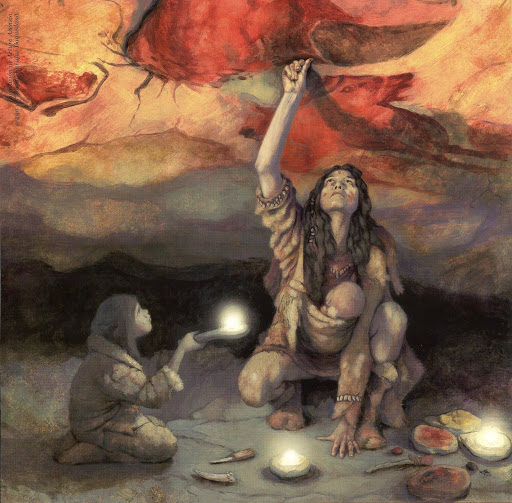
"This vast map covers just about all possible tribes that
were documented in the first centuries BC and AD, mostly
by the Romans and Greeks. Some migration was involved
during this time, and some tribal divisions too, so there
may be a few instances in which names are repeated.
" Click on the small map at this site, and it becomes a
humongous giant map with links for most of the tribes.
"Click anywhere on the map to load the full size map
with links to individual tribes.
German tribes are in orange, Celtic tribes are in blue,
Irish and Picts in green. Tribes who don't fit in those
categories have no color and no links.
"Warning: the full size map is a very large image.
It may take some time to load over slower connections."
![]()
Sumeria Mesopotamia group on FB: Here is
Iku-Shamagan, King of Mari, praying.
Votive statuette
(2650 BCE) Early dynastic period II, from the temple of
Ishtar, Mari, Syria. Height 114 cm
About 4,670 years ago, he was the King of Mari,
an important trading and manufacturing center in
northern Syria. Mari was settled around 5,000 years
ago and it lasted 1,200 years.
The oldest ziggurat
in history, this is the ziggurat
of Uruk.
The original pyramid structure dates back to the Sumerians around 4000 BC.
The white temple was built on the Uruk ziggurat in 3500 BC.
The first writing in history was the Sumerian cuneiform of Uruk, the city
of King Gilgamesh,
the subject of the first literary epic in history.
Source : World Beauties and Wonder.
Lost King of the Maya from PBS Nova. Good little site from the TV show. Excellent interactive map of Mayan cities. Includes teacher guide.
Maya Adventure from the Minnesota Science Museum. Well laid out site with information about culture and history on every known Mayan city! With photo section and project-based learning activities.
Mayan Civilization for Kids Ancient Mayan civilization and culture for kids. Comprehensive and easy to use.
Mayan
Numbers "Mayan Number Symbols. Great for Gifted kids learning why
we use base 10 and other cultures have used different bases." - Sara
Patrick Strait.
The Maya number system was a base twenty system. Explore and enjoy!
Medicine Wheel This is an original Native American wheel, located in the Bighorn Mountains of north central Wyoming. This site has a lot of maps and a LOT of photos of the site. Good information, too. Visit the Wheel. It's ancient, eerie, and the vistas are simply stunning. From the University of Wisconsin. Bighorn Medicine Wheel is a one-page, very informative site, also with plenty of photos.
The Wyoming Medicine
Wheel
In the Bighorn Mountains
 .
.
"One of the prototypical medicine wheels is in
the Bighorn National Forest in Big Horn County,
Wyoming. This 75-foot-diameter (23 m) wheel
has 28 spokes, and is part of a vast set of old
Native American sites that document 7,000
years of their history in that area."
28 spokes equals the number of days in the
monthly lunar cycle.
Another stone circle, the Majorville
Stone Circle
in Alberta, is 5,000 years old!
Medieval Map "This website
illustrates the historical changes that occurred in the Medieval Era (400
- 1500) with an interactive map." Understatement! Move back and forth
through time in 10 to 50 year intervals. Click on one button to show cities,
another to show decisive battles. Click the ? button to see a modern map.
For battles, there is a brief synopsis in a popup window, with the option
to go to Wikipedia. Clicking on a city icon sends you directly to Wikipedia.
The map shows all the contemporary peoples and states for the period you choose.
Clicking on any label (example: "Balts") brings up a three-section
pie graph. One section - the "W", sends you to Wikipedia. Clicking
the folder icon opens up a book or article, if there is one (in this case
an e-book called "The Balts", by Marija Gimbutas). Clicking on the
"film" icon will open a video, if there is one. The site is constantly
being improved. It's quite a trip through time for middle school and older.
Visual learners may finally grasp the idea of huge groups of peoples moving
across Europe. See empires and kingdoms rise and disappear. Wonder at their
names: Avars, Umayyads, White Sheep Turks, Magyars; place names like the Iron
Gates, Polotsk, Navarre, Swabia, Trebizond, and all the rest.
Medieval
remedy for modern day superbug This link goes to the IFLS article. It's
easier for kids to understand. The original University of Nottingham article
is here.
It includes a great video featuring microbiologist Dr Freya Harrison and her
team, and Dr. Christina Lee, the expert translator of the recipe.
"The centuries-old recipe for treating eye infections calls for two types
of Allium (garlic and onion or leek), wine, and oxgall (that’s bile
from an ox). The instructions, translated by University of Nottingham’s
Christina Lee, are incredibly specific: It requires the use of a brass vessel
for brewing, a particular straining technique to purify it, and the mixture
must be left for nine days before use." The scientists followed the recipe
exactly. They found out this eye salve from the 900s kills
MRSA! We wonder what other cures might be hiding in these ancient books?
 Mesopotamia from the
British Museum. Explore the Land Between the Rivers and its ancient civilizations.
Check out Assyria, Babylonia, and Sumer! Learn about ziggurats, Gilgamesh,
gods and goddesses, cuneiform, astronomers, palaces. Play the games!
Mesopotamia from the
British Museum. Explore the Land Between the Rivers and its ancient civilizations.
Check out Assyria, Babylonia, and Sumer! Learn about ziggurats, Gilgamesh,
gods and goddesses, cuneiform, astronomers, palaces. Play the games!
![]() Emma
Elias > We Love Mesopotamia
Emma
Elias > We Love Mesopotamia
Tiglath Pileser III shown in his chariot in this panel from his palace at
Nimrud
The detail of a stone panel decorating Tiglath-pileser's Central Palace at
Kalhu
shows the king standing on his chariot, with his right hand raised in a greeting
gesture during a victory procession. Note the ornate case for the king's bow
hanging above the richly decorated horses' backs.
Photo © British Museum
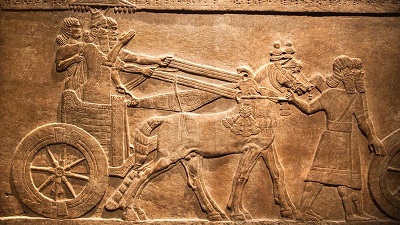
![]() Mr. Donn's Ancient History
Page Lesson Plans & Activities for K-12 teachers & students.
Lesson plans and activities, like it says, for
just about everyone from Aztecs to Vikings. One of the few sites that covers
ancient India and Japan.
Has geography lessons at the 3rd-5th grade level. Also free clip art. LOTS
of social studies lesson plans, up through high school. This is a great site
and a lot of work went into it. Enjoy.
Mr. Donn's Ancient History
Page Lesson Plans & Activities for K-12 teachers & students.
Lesson plans and activities, like it says, for
just about everyone from Aztecs to Vikings. One of the few sites that covers
ancient India and Japan.
Has geography lessons at the 3rd-5th grade level. Also free clip art. LOTS
of social studies lesson plans, up through high school. This is a great site
and a lot of work went into it. Enjoy.
Moundbuilders
Teacher's Guide for Native American Heritage Month. From the American Indian
Cultural Center and Museum (AICCM) of Oklahoma. Excellent self-contained teaching
unit ready to go! Amazing art, artifacts, in-depth discussion of various moundbuilding
Native American cultures over 11,000 years, from prehistoric times to the
1500s. Lots and lots of art! Plenty of activities.
Moundville Archaeological Park site from the University of Alabama. About 800 years ago, this was the largest city in America. Lots of information and pictures.
![]() Making a Mummy from the Children's
Museum of Manchester, UK. Can you make a mummy? You must prepare a body! This
site is interactive, accurate, and kids love the eeeew! gross! aspects. Kids
will be walked through the intricate process . It's easier than some previous
mummy maker games and does not use the late, unlamented Flash.
Making a Mummy from the Children's
Museum of Manchester, UK. Can you make a mummy? You must prepare a body! This
site is interactive, accurate, and kids love the eeeew! gross! aspects. Kids
will be walked through the intricate process . It's easier than some previous
mummy maker games and does not use the late, unlamented Flash.
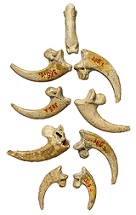 Neanderthal
Necklace
Neanderthal
Necklace
From an article by Zach Zorich, Archaeology Magazine online; June 04, 2015.
"The talons have been dated to about 130,000 years ago, predating the
arrival of Homo sapiens in the area by about 50,000 years.
The talon necklace is now thought to be the earliest known symbolic Neanderthal
artifact."
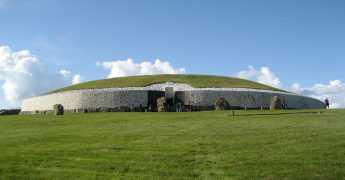 Newgrange
is a 5,000 year old (or older) passage barrow mound in Ireland. It was also
an observatory that tracked the winter solstice. This huge mound has been
100% restored with the original white marble front wall! Many great photos
and information. See photos of the sun hitting the interior during the
winter solstice here.
Newgrange
is a 5,000 year old (or older) passage barrow mound in Ireland. It was also
an observatory that tracked the winter solstice. This huge mound has been
100% restored with the original white marble front wall! Many great photos
and information. See photos of the sun hitting the interior during the
winter solstice here.
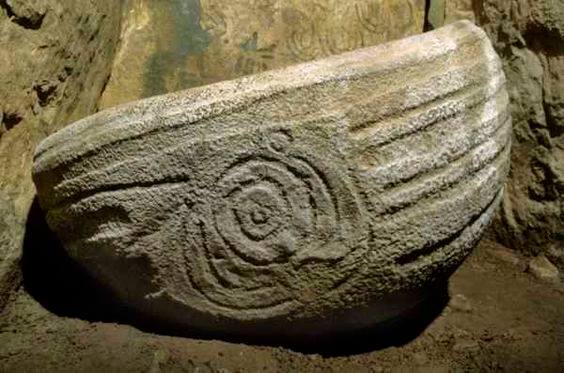 A granite basin located within the great Neolithic tomb at Knowth, Co. Meath,
Ireland. Covered in megalithic art, it held cremated human bones.
A granite basin located within the great Neolithic tomb at Knowth, Co. Meath,
Ireland. Covered in megalithic art, it held cremated human bones.


To give students a passing familiarity
with this old Gaelic writing system.
Oldest
woven basket in the world found in Israel,
dates back 10,500 years
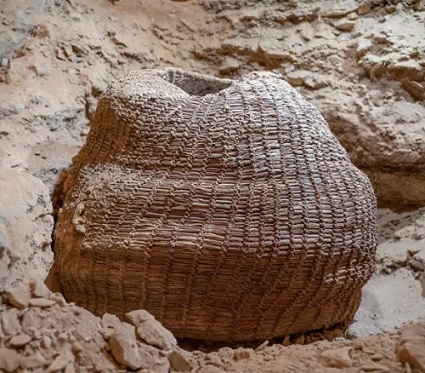
"The basket was found empty and closed with a lid.
Only a small amount of soil was retrieved in it and
the researchers hope it will help identify what the
vessel contained." Read the Jerusalem Post article
by clicking on the link or on the photo.
ORBIS The Stanford Geospatial Network
Model of the Roman World. This is not your normal map! "ORBIS
allows us to express Roman communication costs in terms of both time and expense.
By simulating movement along the principal routes of the Roman road network,
the main navigable rivers, and hundreds of sea routes in the Mediterranean,
Black Sea and coastal Atlantic, this interactive model reconstructs the duration
and financial cost of travel in antiquity." Short version: Travel
the rivers, roads, and seas of the Empire! Find out how long it took and how
much it cost. Lots of ways to get from point A to point X, depends on who
you are and how much money and time you have. There's a menu bar along the
top. Click Using ORBIS to watch
a tutorial (it's good, we recommend it). Click the Adobe Acrobat Reader symbol
at the the top right corner of the page to get the tutorial, lesson ideas,
and explanations in .pdf form. Clever teachers could adapt this for any level
from upper elementary up to college-level. It's that good. Different in purpose
from the excellent
Digital Map of the Roman Empire, but both are quite detailed.
Othere's
Voyage to the White Sea, as told to Alfred the Great
In the late Ninth Century a Norseman arrived at King Alfred of Wessex’s
court.
The stories he told the king were recorded for posterity by a court scribe.
This is a retelling of that Ninth Century document recording the exploits
of
a Ninth Century resident of Norway’s northernmost province.
The video descibes the voyage around the top of Norway and down into the
White Sea. It decribes the peoples Othere encounters, who were
close relatives of Finns and Saami
Old Norse
Map of the Viking World
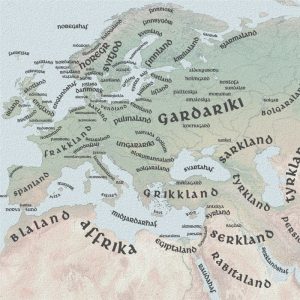
"The geographical range of Viking exploration between the
9th and 12th centuries AD was amazing. From their Northern European homelands
in today’s Norway, Denmark and Sweden they used the Norwegian and Baltic
Seas to engage with the world as looters, traders, colonists and mercenaries."
Clicking on the map enlarges it - you could go from the 768 X 364 size up
to a 5039 X 2413 monster with several intermediate sizes, if you wanted. All
the placenames are in Old Norse. The map also comes in modern English, as
a guide.
A modern shield maiden plunders Iceland.

Oldest Human Skeleton in the Americas
A teenage girl left her remains in Yucutan 13,000 years ago.
Her DNA says she was 100% Native American.
How did her people get to the Gulf coast of Mexico? Did they walk from Siberia?
Watch this video!
Oriental Institute of the University of Chicago is an amazing site offering virtual tours of the Institute's world famous collection of ancient Middle Eastern artifacts! Takes a little practice to use but worth the effort!


Enjoy the interactive 3-D experience and visit the long-gone
buildings and places of Paris across the ages. See Paris as
the home of the Parisi tribe of Gauls. At 1:00 in the video
a trophy shrine is shown, with cow skulls instead of human
heads (Celts were head hunters.).
Next is Roman Paris with temples, baths, a colosseum,
and an amphitheatre. The Roman city is much bigger
and more sophisticated than the Gaulish town.
Also shown in time lapse are the Louvre, Notre Dame
Cathedral, the Bastille, and the Eiffel Tower. 12:58 video.
Passage
Tombs We have a lot of links to sites featuring
passage
tombs/passage graves like Newgrange
in Ireland and Wayland's
Smithy in England. This
link from Ireland is a good
explanation of what makes a burial site a passage grave.
Gavrinis
is a big passage tomb in Brittany, France.
"Gavrinis (Breton: Gavriniz) is a small island in the
Gulf of Morbihan in Brittany, France. It contains the Gavrinis
tomb, a Neolithic passage tomb built around 4200–4000 BC,
making it one of the world's oldest surviving buildings. Stones
inside the passage and chamber are covered in megalithic art.
It is similar to other Neolithic passage tombs such as
Barnenez in Brittany
and Newgrange in
Ireland." - Wikipedia



![]()
The story of the Pazyryk
Carpet
The world's oldest rug
THE PHOENICIANS | Creators of the alphabet.
History for kids, 7 min video
A good upper elementary video, it tells about
trade,
trade routes, colonies, history, Tyrian purple dye,
and the alphabets we use today.
Qin Shi Huang, the First Emperor of China. Uniter of ancient China, founder of the (harsh and short-lived) Qin Dynasty! He was the Emperor in the movie "Hero." Could you unite China? Do you dare enter his tomb? Check out his famous terra-cotta army!
Rameses: Wrath of God, or Man? The Discovery Channel site. Tour Rameses' realm, play the games. Do you have what it takes to be a Pharaoh like Rameses II? And who really won the Battle of Kadesh, anyway?
Roman Empire Animated Map covers expansions and contractions of the Empire from 510 BC to 1453 AD. Animated .gif file would be good for ancient history classes.
Roman Gladiator School found in Austria – three links:
The discovery of the school of gladiators at Carnuntum, Austria - Antiquity Journal. This is the 3:07 video, excellent graphics, good music.
The discovery of the school of gladiators at Carnuntum, Austria - supplementary material pdf file includes three color pictures of the school, starting on page 2
Gladiator School Discovery Reveals Hard Lives of Ancient Warriors - The Carnumtum gladiator school is one of only two found so far, and the only one outside of Rome itself. NatGeo analyzes the lives of those valued slaves, the gladiators.
A Roman Legionary ring of the 6th Legion (Legio VI “Victrix”) commemorating service along Hadrian's Wall and an expedition into Amorica (Brittany). The ring dates from 150 - 225 AD. It is made of an alloy of silver and mercury. It's in pretty good shape to be so old. Photo Copyright 2008 David Xavier Kenney. There are many more rings and other Roman artifacts to see at his main site.
Roman Sites in Scotland "Below is a selection of Roman sites in Scotland. They comprise a legionary fortress (Inchtuthil), an early third century campaign base (Carpow), auxiliary forts of different types (Ardoch, Cramond, Fendoch, and Newstead), and two frontier systems (the Gask Frontier and the Antonine Wall)." There are good aerial photos of these places, which demonstrates the value of aerial archaeology, and more information as well.
Roman Villa A reconstructed Roman villa in England, part of the Butser Ancient Farm group of sites, about an Iron Age farm and a Roman villa later built at the same place. There are also pictures of the rooms in the villa.
![]() Roman
Villa models from Armada Model Designs, Ltd. This has good pictures of
the villa at Butser Ancient
Farm and of villa layouts, but the best part is at the bottom of the page
- you can download FREE PDFs of two sizes of
model Roman villas. The colorful parts, diagrams, and instructions are in
the PDF! You build the villas using card stock. What a school project! They
also have downloads of a Norman castle, pyramids; Fireship - a board game
about the Spanish Armada, and more! What a deal!
Roman
Villa models from Armada Model Designs, Ltd. This has good pictures of
the villa at Butser Ancient
Farm and of villa layouts, but the best part is at the bottom of the page
- you can download FREE PDFs of two sizes of
model Roman villas. The colorful parts, diagrams, and instructions are in
the PDF! You build the villas using card stock. What a school project! They
also have downloads of a Norman castle, pyramids; Fireship - a board game
about the Spanish Armada, and more! What a deal!
The Romans Jordan Allan in the UK has created a fine resource site about everything Roman. This would be quite useful for students from elementary through college level who needed to learn a lot about the Roman world in one place. Covers pretty much all aspects of Roman history and civilization, with videos! Weighed somewhat towards Romans in Britain (naturally), but very useful wherever you are! Thanks, Mr. Allan, for the email!
Romans in Britain is now Primary History - Romans, with a new URL. This is a well done BBC site that concentrates on Romans in Britain. It includes a page on Hadrian's Wall.
Romans in Scotland The BBC Scotland site - different than the BBC site. It's a fine interactive site for learning about Romans, the Roman Empire, the ancient peoples of Scotland, and how they all interacted. Gotta love Maeve and the guid Scots tongue. You could even start learning Gaelic here!
Romans in Scotland Part of the BBC's Romans in Britain site. This site tells the little-known history of Rome's attempt to conquer and occupy Scotland, from around 80 to 140 AD. For more information, go to Roman Sites in Scotland. Play the Cabinet of Curiosities Game, too.
Rome - Mr. Carlton's Rome Unit This is a high quality unit on Roman civilization, made by a 7th grade teacher in California. Part of his social studies site (he also has other units), this is easy to understand and broad-ranging. It would definitely benefit any student and is full of good ideas for teachers, too.
Rome Reborn virtual ancient Rome site. Tour Rome as it grows from a Bronze Age village to 500 AD. Choose still images or Flash movies. Various academic institutions worked on this site, which is hosted by the University of Virginia.
Rome's Imperial Port "The vast site of Portus holds the key to understanding how Rome evolved from a mighty city to an empire." Good article, lots of graphics. This place was HUGE! Huge warehouses, drydocks, sheds for big ships, acres/hectares of protected harbor. It is the ancestor of our giant, modern, automated ports. The actual ship basin is still there! Kudos to Archaeology Magazine.
Stunning 3D Animations Showcase The Internal Layout Of The Roman Domus (House) "... a typical Roman domus served as a dwelling for the Roman familia, while being (sometimes) used as a ‘personalized’ center for business and religious worship." A domus was designed for "higher middle class Roman citizens", when those people were not living at a villa at their country estate. This animation takes you through the house and grounds, and the article shows blueprints and explanations, too. "The resourceful folks over at Ancient Vine and Museum Victoria have given a go at virtually reconstructing the typical Roman domus of a ‘well-to-do’ family."
The second video "showcases the Roman domus of Domitia Longina, wife to the Roman Emperor Domitian, who lived from 55-126 AD. Suffice it to say, the house was bigger than the typical Roman domus, and as such also consisted of a thermae – a bathing facility specifically constructed within the compound of the residence." Superb animation and music.
The third video, Ancient Roman Homes of the Rich, is narrated. Everything important is labelled, in Latin. This video covers things not often discussed in these short videos, such as water, plumbing, radiant heating, baths, the various entrances, dining, and bedrooms. ©2014 David Egan Productions.
![]()
The Rosetta
Stone is one of the most famous objects in the
British Museum.The stone is a broken part of a bigger stone slab.
it has a message carved into it, written in three types of writing.
It was an important clue that helped experts learn to read Egyptian
hieroglyphs, a writing system that used pictures as signs.

The Royal Residence at Tissø in the Viking Age This narrated 3D
video of a royal residence on the west bank of Lake Tissø, on the island
of Sjælland (Zealand), Denmark, gives a good look at how Vikings lived
at home. Good explanations and a few surprises. There's a much longer description
on the site. You can access the video there or here.
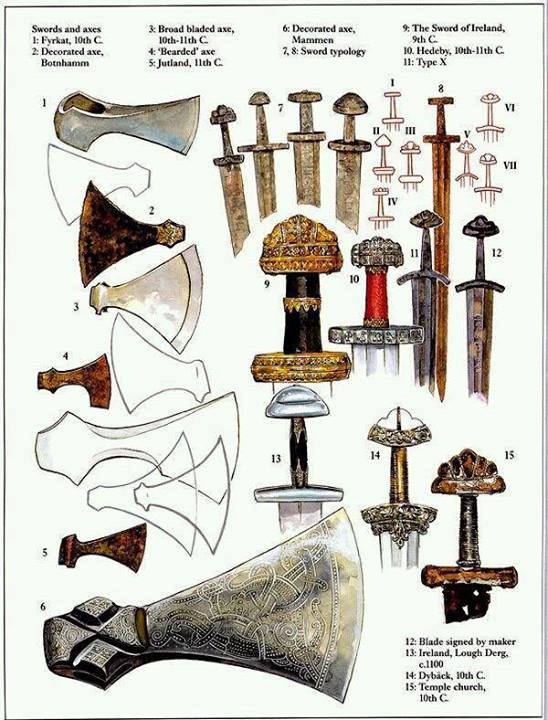
Ancient Craft - Dr. James Dilley
The pinnacle of prehistoric European flintknapping?
Found on the Danish island of Fænø around 1876 this
stunning flint dagger was owned by Hindsgavl Manor
on Funen until it was purchased by the National
Museum of Denmark.
Known as the "Hindsgavl Dagger", it features on
the 100 krone note.It is believed to date from
2400-1800BC based on similar examples which
are known as fish-tail type IV daggers. They come
from a period at the end of Stone Age when status
was shown by the quality of the dagger you owned
or could be buried with. There are suggestions
these late Neolithic daggers were imitations of the
earliest metal examples already in circulation.
There would have been few metalworkers at this
time so their work was very valuable. However
there would have been just as few (if not fewer)
flintknappers who could have produced work as
fine as the Hindsgavl Dagger.
To create the dagger, a large piece of flint would
have been shaped with hammerstones into a
roughout before it was refined with antler hammers
into a dagger blank. Pressure flaking may have been
started to create the final blade shape before it was
ground smooth. With a smooth surface, rippling
flakes could have been detached. The stitching effect
on the handle would have been achieved by pressure
flaking and indirect punchwork.
Sample Plan of a Roman House Easy to use interactive graphic that explores the layout of a wealthy Roman house. Rooms are listed by function; or just click on the letters in the diagram. Each letter links to a page of photos and descriptions.
Solid gold Scythian comb found in Ukraine
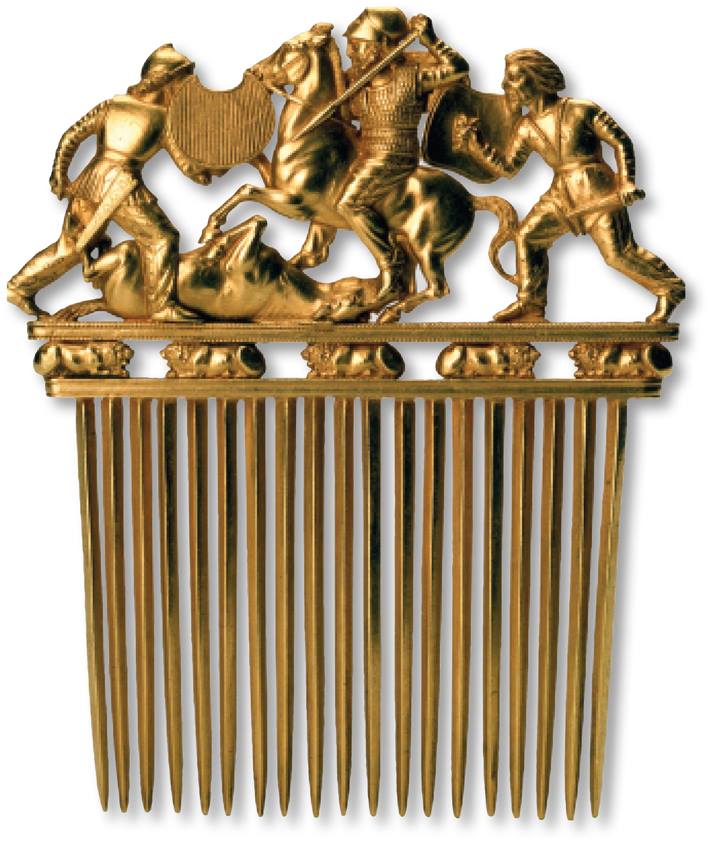
Scythian solid gold pectoral (hung on the chest) 1 Kg/2.54 pounds
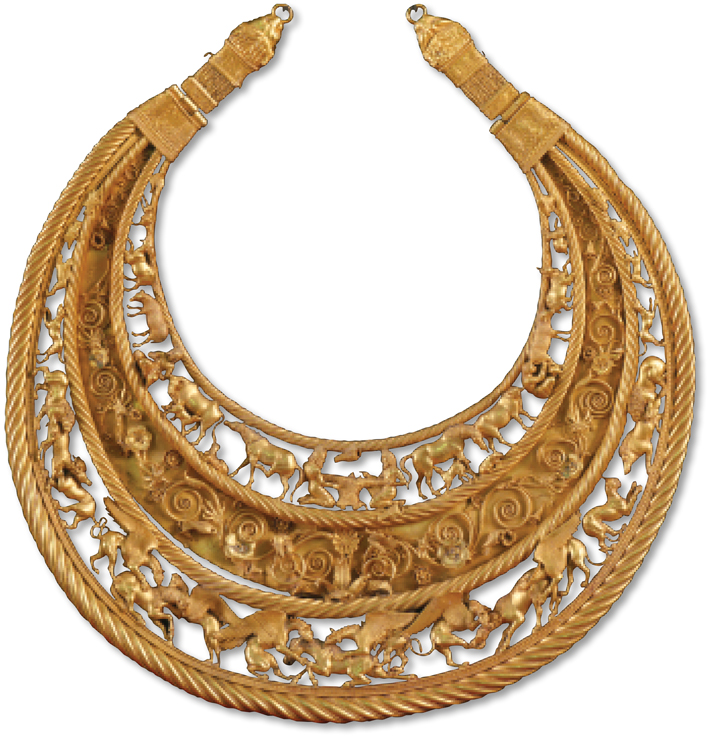
Scythian bow, quiver, and arrows, over 2,000 years old

Seven Wonders of the Ancient World with virtual tours. See the seven wonders "up close and personal." Also shows Stonehenge, the Sphinx, and the Tower of Babel. This site has various ads but the site content is academic.
BBC
Scotland's interactive Skara
Brae site for kids! Examine the evidence and play the activities! Make
bead necklaces, decorate pots, find food and fuel, arrange things in the home,
and plan a stone circle! Great educational site about Neolithic people living
at the edge of Europe about 5,000 years ago.
Spanish Armada ship found off Irish coast with photos and a map of the Armada's unchosen course up the North Sea, west around Scotland, and down past Ireland as they limped home to Spain. Great history here. If the Armada had been successful, Spain would have conquered Britain.
This is Sparta: Fierce warriors of the ancient world "In ancient Greece, violent internal conflict between border neighbors and war with foreign invaders was a way of life, and Greeks were considered premier warriors. Sparta, specifically, had an army of the most feared warriors in the ancient world. What were they doing to produce such fierce soldiers? Craig Zimmer shares some of the lessons that might have been taught at a Spartan school."
SquinchPix Image Resource - "An Archive of European Imagery" Utterly astounding. Many thousands of artifacts, sculptures, paintings, castles, churches, temples, dishes, jars, ancient helmets, Minoan buildings, Pompeii, etc etc etc. All labeled by date made/built and location.
Stone Age Art Caves May Have Been Concert Halls There is good circumstantial evidence for this idea. Rooms with paintings in them have the best acoustics in the caves!
Stone Pages (rhymes with "stone ages?") "Stonehenge, stone circles, dolmens, ancient standing stones, cairns, barrows, hill forts and archaeology of megalithic Europe." Good photos and information on scores of Neolithic sites. Also has QuickTime VR virtual tours of many sites (including Skara Brae!) Simply amazing.
This is Weyland's Smithy in England. Named by the Anglo-Saxon peoples. Named for Weyland (AKA Vulcan, Waylund, Vølundr, Hephaestus) the limping god of metal working. It's actually a Neolithic "passage tomb" from thousands of years earlier. The earth that once covered it was removed at some point in time.

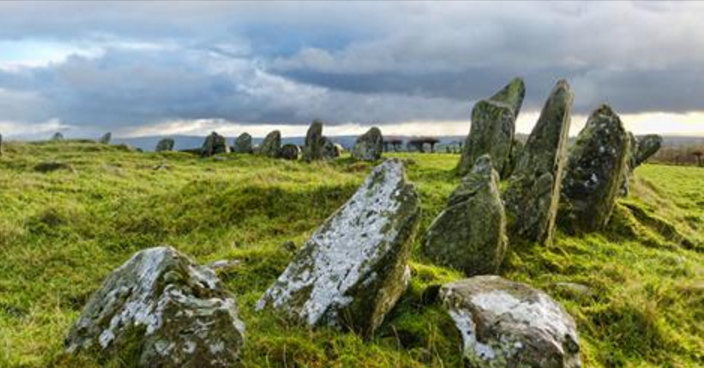
 Stonehenge
Panora 3-D panorama in Shockwave, taken from the center of Stonehenge.
Scroll around and see what it looks like! Read about the hidden
archaeology of Stonehenge, the discovery of a huge complex of ancient
sites under the area. It turns out Stonehenge was just one part of this huge
temple!
Stonehenge
Panora 3-D panorama in Shockwave, taken from the center of Stonehenge.
Scroll around and see what it looks like! Read about the hidden
archaeology of Stonehenge, the discovery of a huge complex of ancient
sites under the area. It turns out Stonehenge was just one part of this huge
temple!
Sun Dagger at Fajada Butte, New Mexico. Short and sweet, this site has a great photo of the "sun dagger" formed by a slice of sunlight hitting a spiral design on a hidden rock. This only happens during the summer solstice. Winter solstice and the vernal and autumnal equinoxes have their own sun daggers. The spiral carving looks an awful lot like the one at Newgrange in Ireland (see above), which is kind of spooky. Another site has more photos and is more technical. Here is a Flash graphic from Exploratorium demonstrating how the Sun Dagger worked.
Sunstones! - Shipwreck Discovery May be Fabled Sunstone - what is it? The Alderney Crystal was originally transparent, but the sea water had turned it a milky white.
Temple of Karnak Great Hypostyle Hall Project. From the University of Memphis (the one in Tennessee). "In architecture, a hypostyle hall has a roof which is supported by columns, as in the Great Hypostyle Hall at Karnak. The word hypostyle comes from the Ancient Greek hypóstylos meaning "under columns". Wikipedia" Kids will like the temple tour the best. This temple was featured in a James Bond movie and also in The Mummy Returns.
Thermae
Maiores Legions of Roman soldiers bathed in this ancient spa complex
under a Budapest transit station. This 15,000-square-meters (160,000-square-feet)
bath serviced the Romans garrisoned here. Several good photos in this
one-page article. Includes directions and hours. The tour is free.
The Thorsberg
Moor, located near Süderbrarup in
Anglia, Schleswig-Holstein, Germany, is a peat bog
where the Angles deposited votive offerings for
approximately four centuries. Among the numerous
artifacts discovered at this site are two round
wooden shields dating back to the 3rd century CE.
(the '200s) These shields are significant as they provide
insights into the weaponry and defensive tools used
during this period. Despite their age, the shields have
been remarkably well-preserved, offering valuable
information about the materials and construction
techniques of the time. The Thorsberg Moor is
recognized for its wealth of archaeological finds,
which, in addition to the shields, include clothing,
both Germanic and Roman, and objects of
both Roman and Germanic workmanship.

These shields look like the ones in Viking movies!

Woman's dress.

Man's red tunic.
 TimeMaps
specialise in map-based history timelines.
TimeMaps
specialise in map-based history timelines.
TimeMaps' FREE interactive World
History Atlas is the most comprehensive history atlas on the internet.
Inside you will find over 1,500 maps, well-written historical overviews, depth-articles,
images and much more.
Maps and timelines (timemaps) of every civilization, nation and empire. See
the geographical context, chronology, connections and big pictures of history.
FREE!" Fabulous interactive maps that branch
off fractally, let students explore everything about the history of any part
of the world from 3500 BC (5500 BP) to the present day. A short video
shows some examples. The Atlas
shows relationships between peoples and civilizations using graphics and text.
It's full of information. There are also very good and inexpensive iPad, iTunes,
and Chrome apps for sale, from $1 to $3 that we saw, and at least one (The
Black Death) for £1.99. Are the apps worth it! In a word, yes! Our historian
was nearly drooling. They also have available various teaching resources and
materials.
Popular Topics Click & grab the big orange button, then slide the
big orange button to see 13 interactive history timelines for different parts
of the world.
This site is everything it claims to be! Enough! Go see it for yourself!
Titanic virtual dive! (and much more) Well, OK, unless you're a kid the Titanic isn't "ancient history", but it IS archaeology! Kids can dive down to the wreck in a virtual sub with a virtual ROV they can operate.
Tree Ring Analysis Part of Bioweb, an excellent Canadian site listed in our Biomes section, over in Science and Nature. Like Dendrochronology, this is a fine lesson on tree ring dating.
Uffington
White Horse site with many photos,

including the nearby "Uffington Castle" Iron Age hill-fort.
This is the huge stylized running
white horse carved into
a chalk hill in southern England 3,000 years ago.
Local residents have maintained it for as long. Perhaps a
Celtic religious site, sacred to the goddess Epona, who
watches over horses. Includes shots of archaeologists
restoring the site. Scroll down to see the photos.
" 'Tain't what a horse looks like, it's what a horse be"
.
- Granny Aching, as quoted by Sir Terry Pratchett.
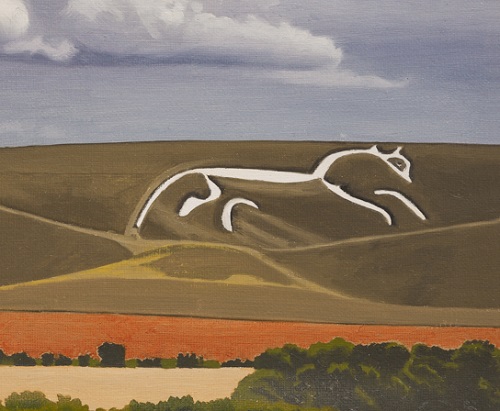
Vendel helmet pre-viking warrior helmet found in a grave
in 7th century AD Sweden. Similar to the Sutton Hoo
helmet found in the UK and the same age.
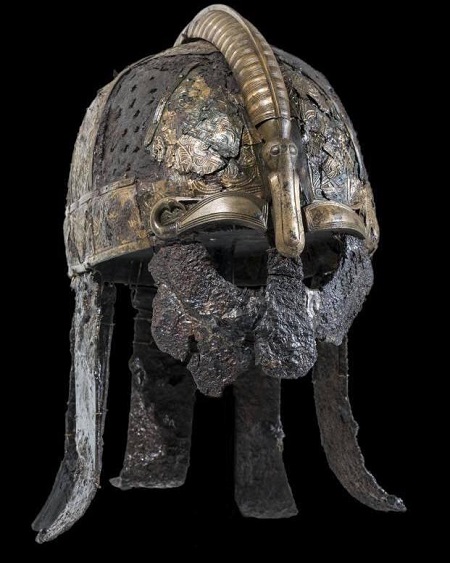
Vesuvius - Pliny the Younger's letter to the historian Tacitus about the eruption and the death of his uncle, Pliny the Elder; and a second letter about his own escape and what it looked like and felt like to be in the volcanic cloud. Pliny the Elder was a senior naval officer who led a squadron of ships to rescue the people of Pompeii. Amazing nearly 2,000 year old letters, great Primary Source for history. Probably best for 5th grade and up, or a literate 4th grader.
Viking Age History from Hurstwic. "To help the public learn more about Viking Age history, we include here links to factual articles written by Hurstwic members. The articles are updated regularly, and we hope to add more articles on a regular basis. A list of some of the references used to create these articles is here. In addition, we have created a short reading list of introductory texts on Viking age topics, for both children and adults." This is mainly for high school and up, although younger students should enjoy many of the drawings and photos. Covers every topic and aspect of Norse and Viking life. Anything a layperson would ever want to learn about the Viking Age is in here, usually well illustrated and thoroughly explained.
Viking Quest is an online game from the BBC Ancient History site. Players must plan, prepare, and execute a raid on the monastery at Lindesfarne. Gives good insights into what it meant to be a Viking and a Viking's victim. Hints: take the chief's gold, do not land in front of the monastery, do not burn the monastery.
Viking
Sword Discovered in Norway ![]()
from the Museum
of Cultural History, University of Oslo, via Archaeology.
[PAYWALL]
"The sword must have belonged to a wealthy man in the late Viking Age.
But who was he and what magic inscriptions are set into the decoration - in
gold?
Was the owner of the sword in the Danish King Canute’s* army when it
attacked England in 1014-15?"
The Archaeology article is short and covers the basics very well.
The Museum's article gets into the sword's origins, the times, the cuture,
and more.
* King Canute's "real" name was Knut Svensson (Sven's son), son
of King Sven "Fork-beard" Haraldsson
King of Denmark and the Danelaw; grandson of King Harald "Blue-Tooth"
Gormsson of Denmark;
and great-grandson of King Gorm the Old, the first king to unite Denmark.
*
* Denmark back then included a big chunk of what is now southern Sweden, too.
Also we know Knut was pronounced "Kuh-noot", not "noot"
(because "Canute" has the hard C).
Viking
Sword from the High Mountains of Norway "This Viking sword was found
by reindeer hunters
at high altitude in the Mountains of Oppland County. It may have belonged
to a Viking who lost his way
and died here 1100 years ago." It's a classic longsword, well made of
good steel. It lay on the ground
for about 1,100 years. It did not rust away. Most of the time it was frozen
hard in ice. Until
recently, this was a glacier. It was a pass between two villages. The ice
melted due to global warming.

Full sized photos are available at the site. Click any photo to get there.


Vikings is one of the new BBC "ancient" sites for kids, and it's quite good. Comprehensive, covers Viking history and home life. Naturally emphasis is on the UK. The Fun Facts are interesting and relevant. Play the "Thorkel and the trading voyage" game for a cultural tour of ancient "old" York ("Jorvik"). Then go on to Dig It Up: Vikings, and do some digging. There are plenty of pdf learning activities scatted throughout the pages of this site, and plenty of photos, too.
Vikings Who Were the Vikings? is the companion site to the PBS Nova TV program of the same name. Interesting and factual.
Virtual Egypt Live from Ancient Egypt! Photo tours, games, facts, links, it's all here!
Villagers
Just Uncovered 2,500-Year-Old Ruins
Belonging To The ‘Cloud People’ On A Mexican
Mountaintop from all That's Interesting
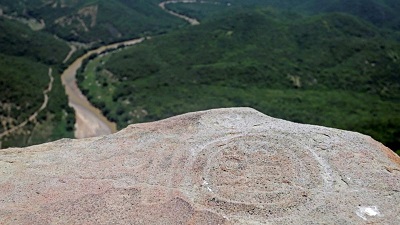
The view from the temple. The old Zapotec people
liked to live way up high. They were called "Cloud
People". Modern Zapotecs still live in the local
area in Oaxaca state.
![]()
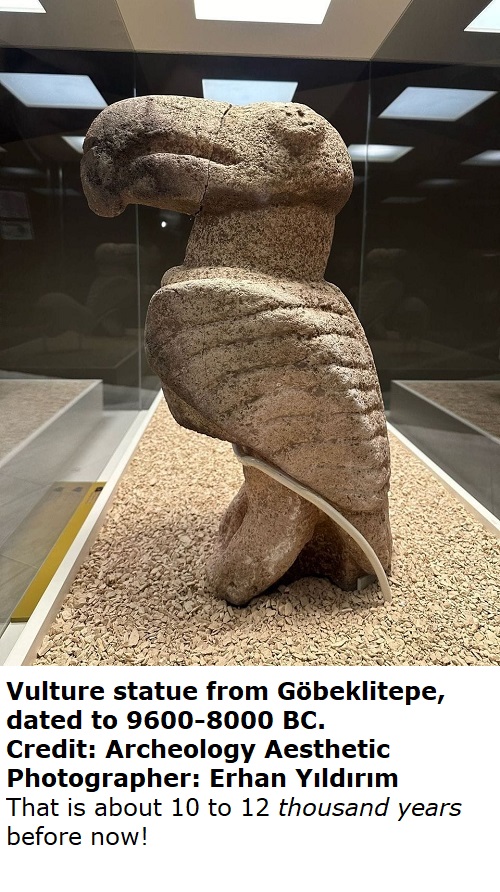
Visit
with Respect
The award-winning video "Visit with Respect" shows how Pueblo
people feel about tourists visiting archaeological sites. It was
filmed at Canyons of the Ancients National Monument and
Acoma Pueblo, and features members of the Hopi Tribe and
Santa Clara and Acoma Pueblos.
The Vore Buffalo Jump,
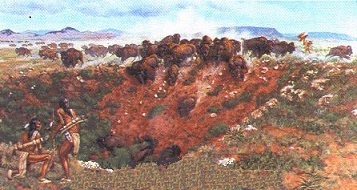
one of North America's most important and
spectacular Plains Indian archaeological sites,
is a stone's throw from I-90 just west of
Spearfish SD. See the excavation and learn
the history, science and culture.
There's another jump (unexcavated), the
Sanson
Buffalo Jump, in Wind Cave
National Park.
Watch 3D Animated Versions Of Solomon’s Temple
Three very viewable videos, each different than the others.
This was likely the standard temple design that Phoenician contractors
put up for temple customers. Customized add-ons like the giant bath
bowls were extra. It came with butresses, too. (The added on buildings
on each side.) An ancient form of quake-proofing. Sounds like
Hiram of Tyre built them to last.
(Said King Solomon to Hiram: "You Hiram?" "Yep. And I fire
'em, too!")

Were the Middle Ages Dark? 5:46 video. There is no period in history more misunderstood than the Middle Ages. Providence College Professor of English, Anthony Esolen, vividly demonstrates why the "Dark Ages" would be better described as the "Brilliant Ages." His debatable points would make a good springboard for discussions in an AP class.
What things cost in Ancient Rome Wages and prices in 301 AD in the Roman Empire. This site gives insight into what it was like to live and work in the Empire - a valuable historical tool. The data could be used for all sorts of teacher-created lessons.
Which Marauding Barbarian Horde are you? By Medievalists.net. "Your people have wandered the vast steppes of Eurasia for generations. Suddenly glittering before you are the spires and domes of great cities, filled with people soft from wine and not having to ride in a saddle for 12 hours a day. Which barbarian horde are you?" Take the quiz, answer a few questions, and find out! You could be anyone from the Huns to the Mongols!
Who Were The Celts? The British Museum Offers Answers with New Exhibition. Celtic (hard "c") cultures once spread across ancient Europe, with similar languages and lifestyles. These exhibits come from all over. The 25 minute video at this site explains all of this and more, so watch it, please. The boar's head war trumpet at 15:00 is outstanding.
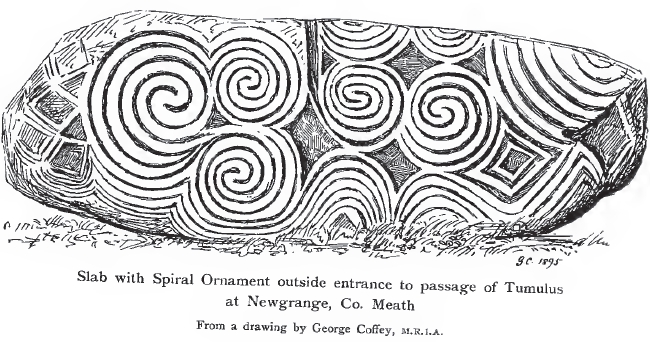
Who's Who in Greek Mythology from Mr. Donn. His usual great treatment of a subject. A collection of links to Greek myths including the 12 Olympian gods.
Winged Sandals "Take the tour with Hermes the messenger god, through a magical place filled with awesome gods, daring heroes and fabulous monsters." Tour ancient Greece with this very interactive site from Australia.
Wizard of Alderney Edge This is a wonderful rhyming video poem from students of Bradford University, UK. It has good animation and music, and the narration is great! Covers some good ancient English mythic themes (sacred mounds and sacred wells, white horses, armies asleep underground). Good stuff! Thanks to Josie Whitehead, who listed this video on her stupendous site - Josie's Poems.
Women
Scientists of Antiquity This article appeared in the March 2017 issue
of Discover magazine.
Credit for the article: Lacy Schley is listed as the author.
Since it can't be read online (paywall) unless you have a subscription (which
we do), we will share it online here,
on our educational site. Or you can always buy the magazine, anywhere. "Marie
Curie. Rosalind Franklin. Ada Lovelace.
Before these wonder women of modern science could make their marks, another
group of females would leave their
own scientific legacies in great, ancient civilizations." Presenting
the famous five:
2700 B.C.: Merit Ptah
The Egyptian physician was the first woman in medicine, and perhaps all of
science, mentioned by name in texts.
Her son, a high priest, called her “the chief physician,” and
her portrait appears in a tomb in the Valley of the Kings.
2300 B.C.: Enheduanna
A Sumerian woman appointed as high priestess of the moon goddess. Her prestigious
religious title included duties
related to astronomy, such as establishing observatories and tracking the
movements of the moon and stars.
1200 B.C.: Tapputi-Belatikallim
A Babylonian perfumer considered the world’s first chemist and first
mentioned in cuneiform tablets.
“Belatikallim” is a title suggesting she might have been a high-ranking
scientist.
Third century B.C.: Agnodike
Grecian law at the time forbade women from studying or practicing medicine
— punishable by death.
So Agnodike dressed as a man to learn the trade. She established a reputation
as an expert
in women’s diseases before revealing herself, which helped overturn
the law.
First century A.D.: Miriam the Jewess
This alchemist lived in Alexandria and is perhaps the first female scientist
to have her work preserved in any form.
Descriptions of her designs for alchemical and chemical equipment were included
in Egyptian encyclopedias
compiled in the third century A.D.
![]() to top of page
to top of page ![]()
![]() to Good Sites
to Good Sites
Here's an "ancient" Brittany photo.